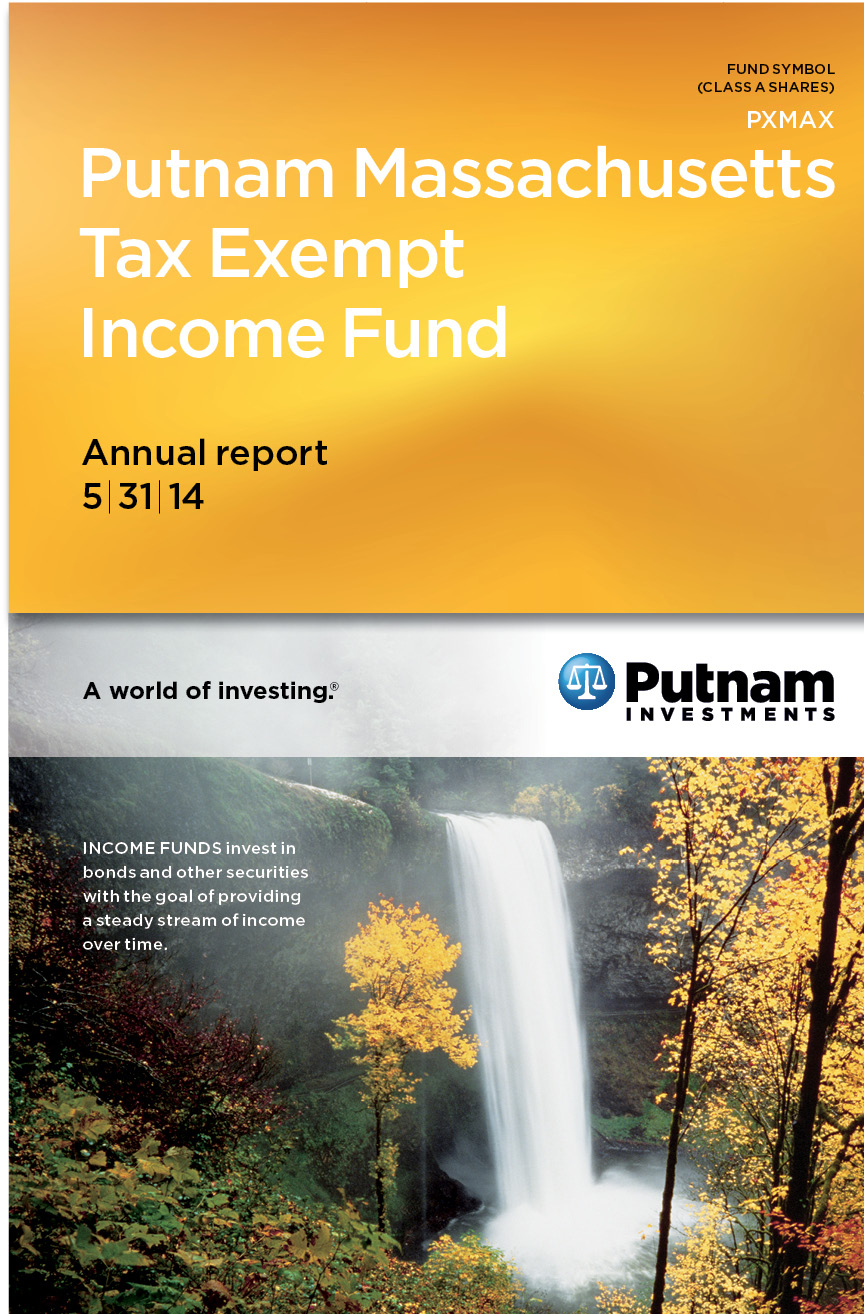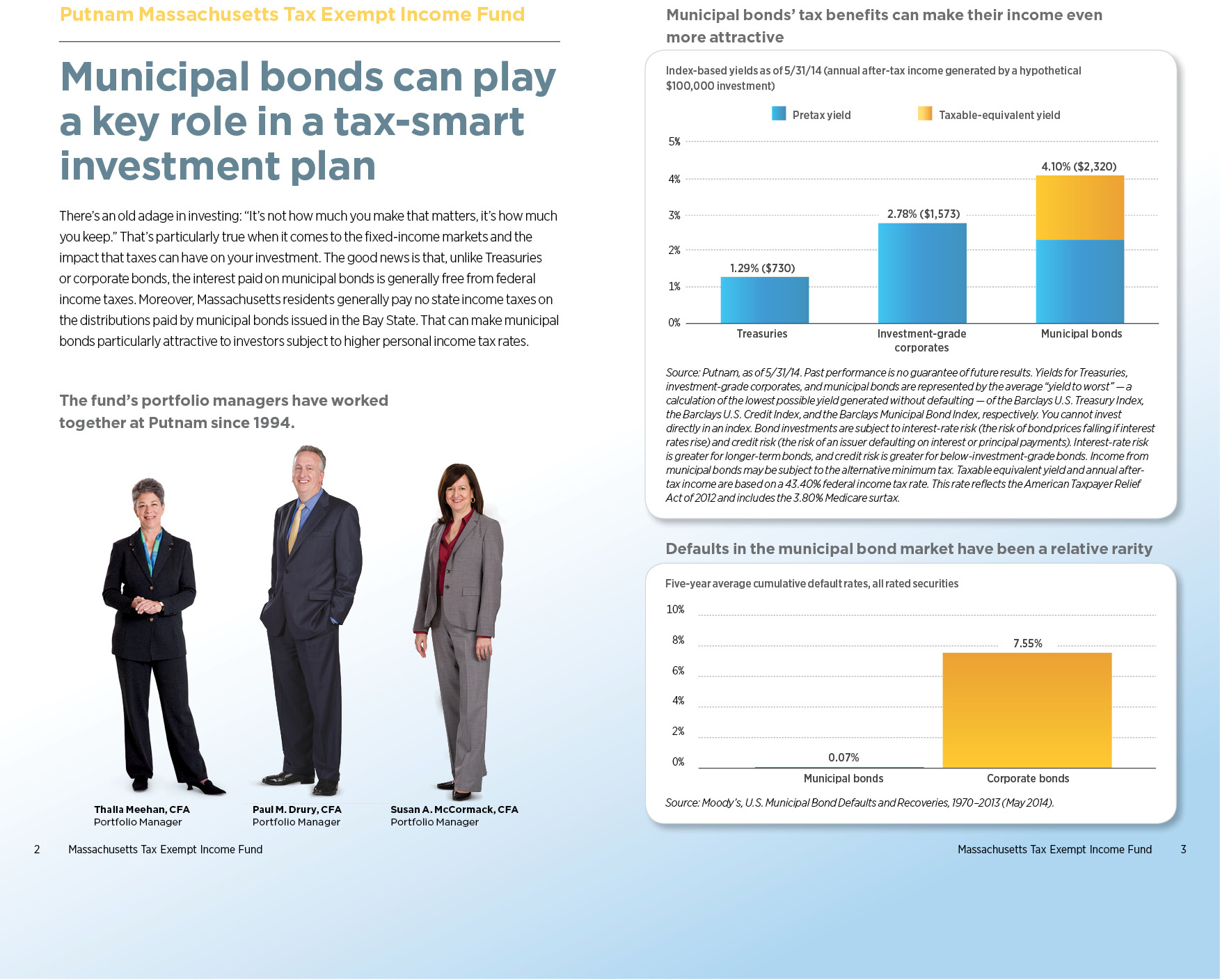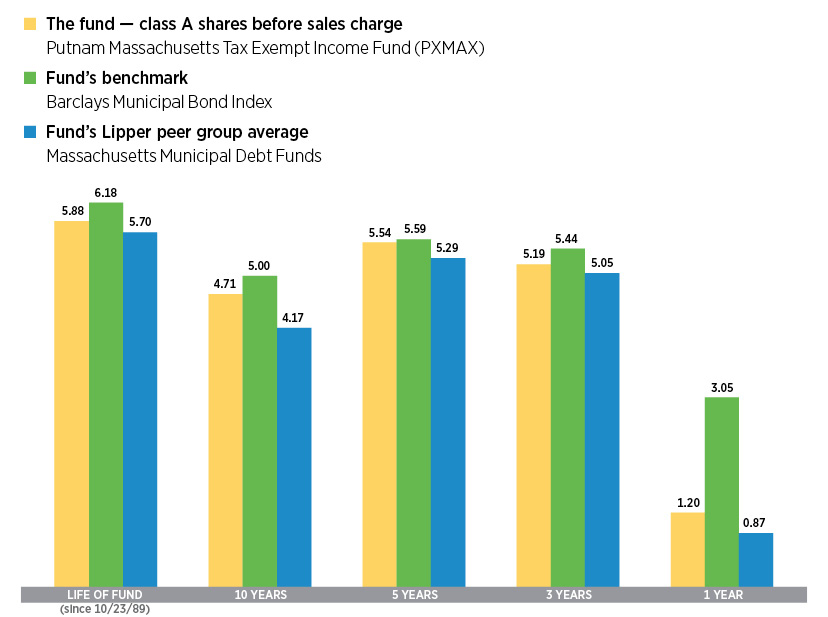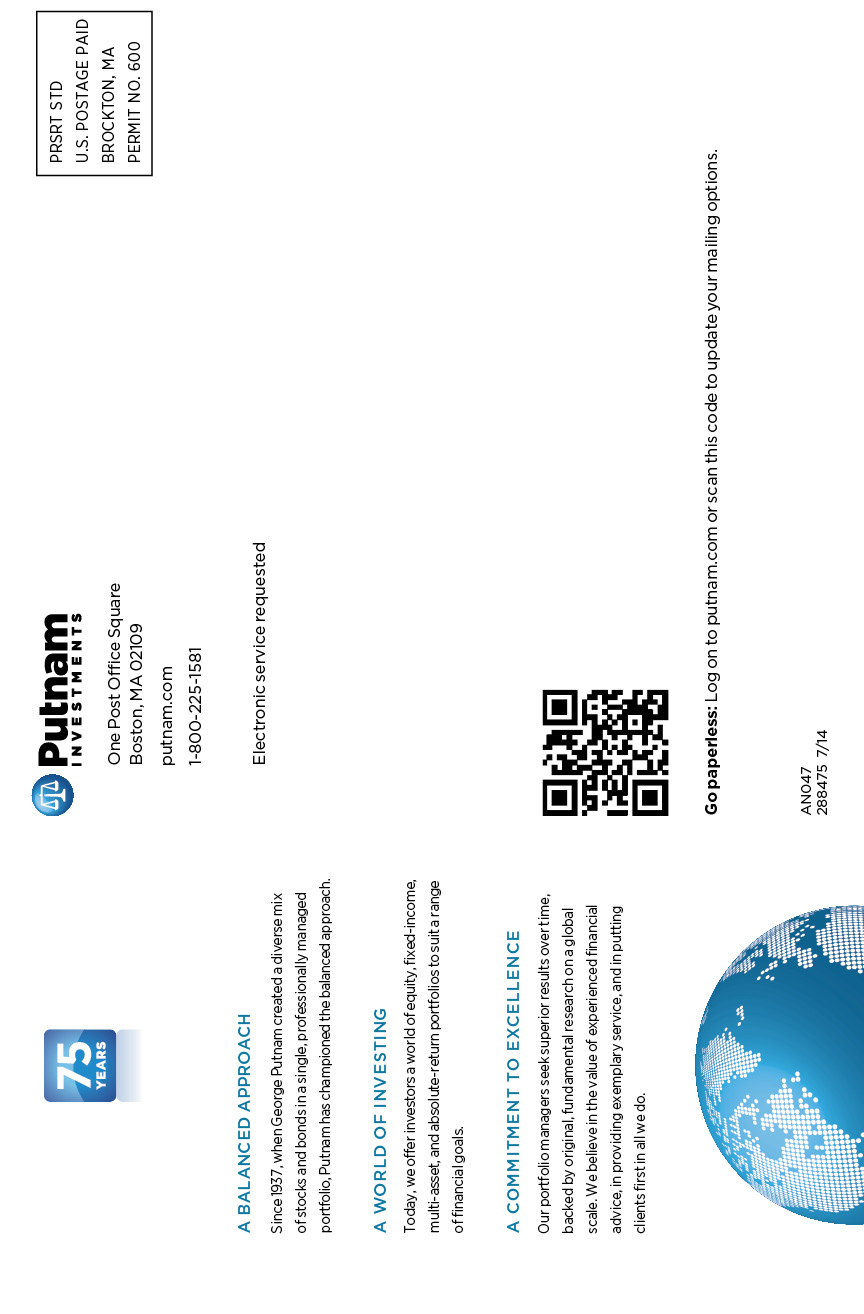Putnam Massachusetts
Tax Exempt
Income Fund
Annual report
5 | 31 | 14
Message from the Trustees | 1 |
About the fund | 2 |
Performance snapshot | 4 |
Interview with your fund’s portfolio manager | 5 |
Your fund’s performance | 11 |
Your fund’s expenses | 14 |
Terms and definitions | 16 |
Other information for shareholders | 17 |
Important notice regarding Putnam’s privacy policy | 18 |
Financial statements | 19 |
Federal tax information | 40 |
Shareholder meeting results | 41 |
About the Trustees | 42 |
Officers | 44 |
Consider these risks before investing: The value of bonds in the fund’s portfolio may fall or fail to rise over extended periods of time for a variety of reasons, including general financial market conditions, changing market perceptions of the risk of default, changes in government intervention, and factors related to a specific issuer. These factors may also lead to periods of high volatility and reduced liquidity in the bond markets. Single-state investments are at risk of common economic forces and other factors affecting a state’s tax-exempt investments. This may result in greater losses and volatility. Capital gains, if any, are taxed at the federal and, in most cases, state levels. For some investors, investment income may be subject to the federal alternative minimum tax. Bond investments are subject to interest-rate risk (the risk of bond prices falling if interest rates rise) and credit risk (the risk of an issuer defaulting on interest or principal payments). Interest-rate risk is greater for longer-term bonds, and credit risk is greater for below-investment-grade bonds. Unlike bonds, funds that invest in bonds have fees and expenses. Tax-exempt bonds may be issued under the Internal Revenue Code only by limited types of issuers for limited types of projects. As a result, the fund’s investments may be focused in certain market segments and be more vulnerable to fluctuations in the values of the securities it holds than a more broadly invested fund. Interest the fund receives might be taxable. You can lose money by investing in the fund.
Message from the Trustees
Dear Fellow Shareholder:
The performance of financial markets in the first half of 2014 has been marked by a significant degree of stability. Investors have regained a positive outlook as economic growth has improved after the setbacks of a harsh winter. The S&P 500 Index and the Dow Jones Industrial Average have risen to record highs, while Treasury yields have gradually sunk lower. Meanwhile, accommodative central bank policies in the United States and elsewhere continue to foster positive sentiment, notwithstanding the fact that the U.S. Federal Reserve has gradually begun to taper its monthly bond purchases.
The relative calm in financial markets contrasts with new disruptions in global affairs. The outbreaks of violent conflict in Ukraine and Iraq have contributed new uncertainties, particularly with regard to energy prices. Markets have generally taken the initial phases of these events in stride, but the risks that these events pose warrant monitoring.
Complex market conditions reinforce why investors can benefit from seeking advice and maintaining a long-term perspective for their financial programs, rather than responding to short-term market movements. Putnam is prepared to serve investors’ goals through a commitment to ongoing fundamental research and a willingness to incorporate new ways of thinking in its investment strategies. This stance has had a positive impact on performance: Barron’s ranked Putnam second among 55 fund families based on total return across asset classes for the five years ending December 2013.
We encourage you to periodically meet with your financial advisor to discuss the range of investment strategies that Putnam offers. Your advisor can help you assess your individual needs, time horizon, and risk tolerance — important considerations as you work toward your investment goals.
As always, thank you for investing with Putnam.
Respectfully yours,

Robert L. Reynolds
President and Chief Executive Officer
Putnam Investments

Jameson A. Baxter
Chair, Board of Trustees
July 10, 2014
How Barron’s ranked the fund families:
The Barron’s/Lipper Fund Family Ranking published February 8, 2014, ranked Putnam 1 out of 61 for 2009, 14 out of 57 for 2010, 57 out of 58 for 2011, 1 out of 62 for 2012, and 2 out of 64 for 2013 for the 1-year period with funds in five categories: U.S. equity, world equity, mixed asset, taxable bond, and tax-exempt bond. Putnam ranked 43 out of 54 and 46 out of 48 for the 5- and 10-year periods ending 2009, 41 out of 53 and 38 out of 46 for the 5- and 10-year periods ending 2010, 49 out of 53 and 41 out of 45 for the 5- and 10-year periods ending 2011, 27 out of 53 and 36 out of 46 for the 5- and 10-year periods ending 2012, and 2 out of 55 and 32 out of 48 for the 5- and 10-year periods ending 2013, respectively. Only funds with at least one year of performance were included. Returns were calculated minus the effects of sales charges and 12b-1 fees. Rankings were asset weighted, so larger funds had a greater impact on a fund family’s overall ranking, and then weighted by category, with each category assigned a percentage. Past performance is not indicative of future results. Barron’s is a registered trademark of Dow Jones & Company. Lipper ranked Putnam Massachusetts Tax Exempt Income Fund 49% (21/42), 29% (11/38), and 19% (6/31) for the 1-, 5-, and 10-year periods, respectively, as of 6/30/14, in the Massachusetts Municipal Debt Funds category. Lipper rankings for class A shares are based on total return without sales charge relative to all share classes of funds with similar objectives as determined by Lipper.
Performance
snapshot
Annualized total return (%) comparison as of 5/31/14
Current performance may be lower or higher than the quoted past performance, which cannot guarantee future results. Share price, principal value, and return will fluctuate, and you may have a gain or a loss when you sell your shares. Performance of class A shares assumes reinvestment of distributions and does not account for taxes. Fund returns in the bar chart do not reflect a sales charge of 4.00%; had they, returns would have been lower. See pages 5 and 11–14 for additional performance information. For a portion of the periods, the fund had expense limitations, without which returns would have been lower. To obtain the most recent month-end performance, visit putnam.com.
4 Massachusetts Tax Exempt Income Fund
Interview with your fund’s portfolio manager

|
Thalia Meehan, CFA |
Thalia, what was the municipal bond market environment like during the 12 months ended May 31, 2014?
Municipal bonds closed out the reporting period in positive territory, despite considerable month-to-month volatility stemming from headline and interest-rate fears. Interest rates and bond yields generally rose during the first half of the period, as investors grappled with the Federal Reserve’s statements that it was considering a timetable for winding down its stimulative bond-buying program, known as quantitative easing [QE]. Municipal bonds came under selling pressure in the June to August 2013 time frame, despite assurances from the Fed that the scaling back of QE would be tied to improvements in the U.S. economy. Headline credit situations — most notably Detroit’s bankruptcy and Puerto Rico’s credit challenges — also concerned investors, which in turn led to further fund outflows and downward pressure on municipal bond prices.
Municipal bonds rallied after the Fed’s September announcement that it would wait for further evidence of improvement in the labor market before setting a time frame for tapering. Municipal bonds continued this momentum into October, when lawmakers agreed to extend the U.S. borrowing authority, avoiding a possible debt default. However, the asset class lost ground slightly in November and December, as questions about the Fed’s

Broad market index and fund performance
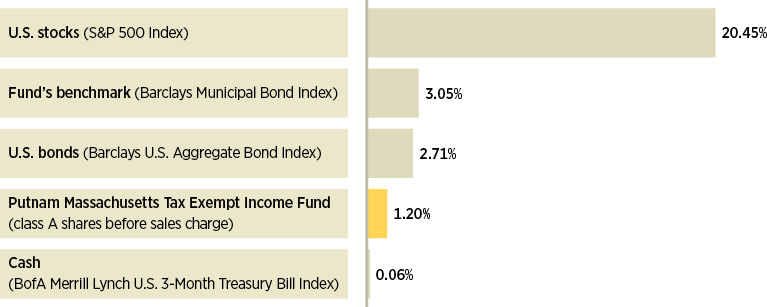
This comparison shows your fund’s performance in the context of broad market indexes for the 12 months ended 5/31/14. See pages 4 and 11–14 for additional fund performance information. Index descriptions can be found on page 16.
Massachusetts Tax Exempt Income Fund 5
monetary policy caused investors to be more cautious.
The municipal bond markets reversed course in January, posting a gain of almost 2% for the month, as measured by the Barclays Municipal Bond Index. This strong monthly return was sparked by a rally in interest rates, as investors moved to a risk-off mode around fears surrounding weaker-than-anticipated economic data and developing stress in emerging markets. In February, with the U.S. debt ceiling debate settled until March 2015, the environment for the credit markets continued to improve. The positive momentum flowed into March, making the first quarter of 2014 one of the three best for the asset class in the past 20 years. March also saw fiscally strained Puerto Rico come to market with its $3.5 billion in G.O. [general obligation] bonds — the largest bond issuance on record, which was met with solid demand. In April and May, municipal bond prices climbed higher as broader economic data started to pick up and market technicals [supply/demand factors] continued to be a tailwind and helped support bond prices.
What contributed to the improving technicals in the municipal bond market?
Municipal bond issuance, which has been trending down in recent years, continued at a modest pace, and this was beneficial for municipal bond prices. The modest level of new supply has not kept pace with the solid demand from traditional tax-sensitive retail investors as well as from crossover taxable buyers drawn to the competitive yields and attractive relative value offered

Sector allocations
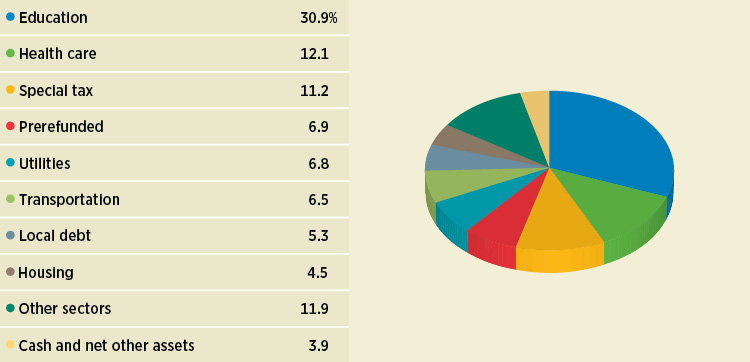
Allocations are shown as a percentage of the fund’s net assets as of 5/31/14. Cash and net other assets, if any, represent the market value weights of cash, derivatives, short-term securities, and other unclassified assets in the portfolio. Summary information may differ from the information in the portfolio schedule notes included in the financial statements due to the inclusion of derivative securities, any interest accruals, and the use of different classifications of securities for presentation purposes. Holdings and allocations may vary over time.
6 Massachusetts Tax Exempt Income Fund
“Our defensive strategies remained in
place, since we expected continued
pressure on interest rates over the
longer term.”
Thalia Meehan
by this asset class rather than by its tax benefit. Meanwhile, inflows to tax-free mutual funds, an important measure of demand, turned slightly positive in the first quarter of 2014 — primarily in tax-free high-yield bond funds. April and May saw a continuation of this strong investor interest. All told, with interest rates still low and fundamental credit quality improving during the period, there was greater investor appetite for the yields offered by the relatively riskier municipal bonds further out on the maturity spectrum as well as for those in the lower-rated, higher-yielding sectors.
How did Putnam Massachusetts Tax Exempt Income Fund perform against this backdrop?
As the reporting period progressed, the environment became more hospitable for municipal bonds, which were supported by low supply, strong demand, and generally falling interest rates. For the 12 months ended May 31, 2014, the fund generated positive returns that surpassed the average return of its Lipper peer group but lagged its benchmark, the Barclays Municipal Bond Index. We believe the fund underperformed its nationally diversified benchmark because of its single-state focus.

Credit quality overview
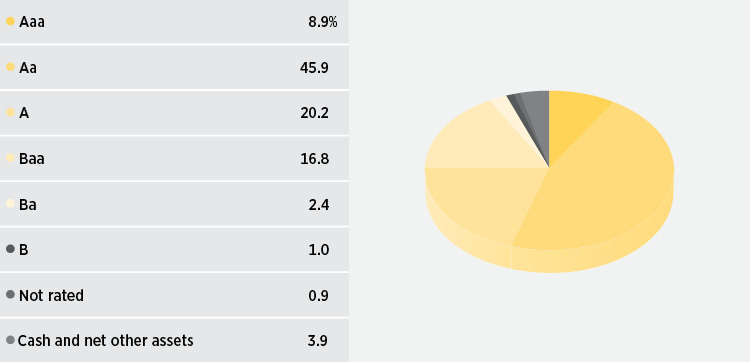
Credit qualities are shown as a percentage of the fund’s net assets as of 5/31/14. A bond rated Baa or higher (MIG3/VMIG3 or higher, for short-term debt) is considered investment grade. The chart reflects Moody’s ratings; percentages may include bonds or derivatives not rated by Moody’s but rated by Standard & Poor’s (S&P) or, if unrated by S&P, by Fitch ratings, and then included in the closest equivalent Moody’s rating. Ratings may vary over time.
Cash and net other assets, if any, represent the market value weights of cash, derivatives, short-term securities, and other unclassified assets in the portfolio. The fund itself has not been rated by an independent rating agency.
Massachusetts Tax Exempt Income Fund 7
What were your key investment themes?
Our defensive strategies remained in place, since we expected continued pressure on interest rates over the longer term as the Fed unwinds its economic stimulus program and investors adjust their expectations about the central bank’s monetary policy.
Ten-year U.S. Treasury yields were especially volatile in January 2014, initially falling from a high of 3.03% to a low of 2.58% before trading in a defined range for the remainder of the first quarter. The release of some weaker-than-expected economic data, coupled with the Fed’s announcement that it would taper bond purchases by an additional $10 billion per month in February, fueled concern over the pace of economic growth in the United States. Higher-risk assets sold off as investors moved into safe-haven U.S. Treasuries. Comments by Fed Chair Janet Yellen following the central bank’s March meeting seemed to come as somewhat of a surprise to the market, as she implied that interest-rate hikes could begin as early as the first quarter of 2015 if the pace of tapering bond purchases continued on its current path. However, those fears generally had eased by the end of the reporting period.
Amid this volatility, we kept the fund’s duration positioning, or interest-rate sensitivity, below that of its Lipper peer group. This included maintaining a slightly higher cash position in the portfolio to help shelter it from price pressures in an interest-rate environment that might be trending higher. We believe carrying slightly higher-than-average cash balances affords the fund greater flexibility to purchase what we consider to be attractively valued

Comparison of top sector weightings
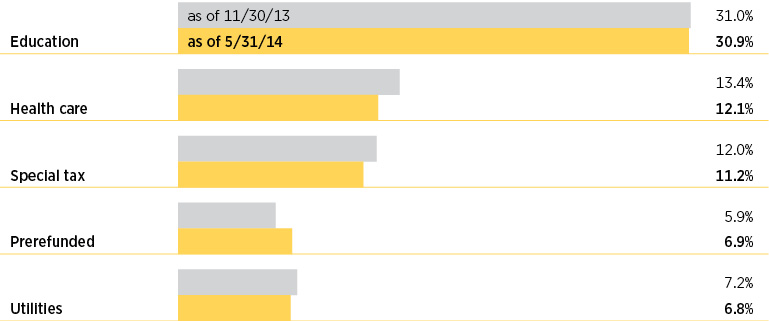
This chart shows how the fund’s top weightings have changed over the past six months. Allocations are shown as a percentage of the fund’s net assets. Current period summary information may differ from the information in the portfolio schedule notes included in the financial statements due to the inclusion of derivative securities, any interest accruals, and the use of different classifications of securities for presentation purposes. Holdings and allocations may vary over time.
8 Massachusetts Tax Exempt Income Fund
bonds even in a rising-rate environment. We continued to emphasize essential service revenue bonds, which are typically issued by state and local government entities to finance specific revenue-generating projects. While we believe that conditions are improving at the state and local levels, we continued to underweight local G.O. bonds relative to the Lipper peer group. These securities rely on the taxing power of the issuer and the health of the local economy to make payments on these bonds.
What did this cautious undertone mean for the fund’s positioning during the reporting period?
Relative to the fund’s Lipper peer group, we maintained an overweight exposure to municipal bonds rated Baa. The fund’s shorter-duration interest-rate positioning detracted from returns relative to its Lipper peer group as rates moved lower during the second half of the period. In terms of sectors, relative to the fund’s Lipper peer universe, we favored higher education, utility, and continuing-care retirement community bonds. This credit positioning contributed to the fund’s performance. The portfolio’s exposure to Puerto Rico detracted from returns over the period. After Puerto Rico issued new bonds in March 2014, there was short-term improvement in the country’s outlook, and Puerto Rico bonds rallied accordingly. Thus, our underweight positioning detracted from performance relative to the fund’s Lipper peer group for the period.
What is your near-term outlook for the municipal bond market?
Over the course of the reporting period, interest rates and bond yields fell, bond prices rose, and investors appeared more willing to take on risk — suggesting, in our view, that investors believe Fed policy is going to remain accommodative for some time. In the closing weeks of the period, the markets were encouraged by Yellen’s May 7 testimony to lawmakers. Yellen suggested that the central bank would probably end its bond-buying stimulus program in the fall of 2014, if the labor market continued to improve. She noted that “a high degree of monetary accommodation remains warranted” with inflation and employment still far from the central bank’s goals.
Despite the strong start for municipal bonds in 2014 and our belief that the credit outlook for municipal bonds appears solid given improvement in U.S. growth, we still remain cautious and believe that there could be some volatility surrounding supply/demand factors and interest rates in the coming months. With regard to tax policy, we think comprehensive tax reform is unlikely at least until after the 2014 mid-term elections. Over the longer term, we believe federal deficits and pressures around social programs will likely contribute to the ongoing debate for broader tax reform, which could affect the value of municipal bonds.
Against this backdrop, we plan to maintain the fund’s defensive duration because we believe that the municipal bond market’s attractive returns thus far in 2014 can be attributed primarily to a combination of robust demand and limited supply of new bond issuances. We also remain cautious with respect to municipal securities at the lower end of the credit spectrum.
Thank you, Thalia, for your time and insights today.
The views expressed in this report are exclusively those of Putnam Management and are subject to change. They are not meant as investment advice.
Please note that the holdings discussed in this report may not have been held by the fund for the entire period. Portfolio composition is subject to review in accordance with the fund’s investment strategy and may vary in the future. Current and future portfolio holdings are subject to risk.
Massachusetts Tax Exempt Income Fund 9
Portfolio Manager Thalia Meehan holds a B.A. from Williams College. Thalia joined Putnam in 1989 and has been in the investment industry since 1983.
In addition to Thalia, your fund’s portfolio managers are Paul M. Drury and Susan A. McCormack.
IN THE NEWS
The unusually harsh winter in the United States and the Ukraine conflict led the World Bank to cut its outlook for global economic growth for 2014. In its June “Global Economic Prospects” report, the bank reduced its global growth forecast to 2.8% from the 3.2% projection it issued in January. Fortunately, the reduction reflects the slowdown that occurred during the winter, and developed economies appear poised to bounce back. Growth in the United States and Europe is expected to quicken as the effects of government spending cuts diminish, more people find jobs, and consumer and corporate demand rebounds, the bank reported. Meanwhile, many emerging-market economies continue to face headwinds. The bank also warned of a “hard landing” in China that could weigh down East Asian countries and hurt commodity exporters.
10 Massachusetts Tax Exempt Income Fund
Your fund’s performance |
This section shows your fund’s performance, price, and distribution information for periods ended May 31, 2014, the end of its most recent fiscal year. In accordance with regulatory requirements for mutual funds, we also include performance information as of the most recent calendar quarter-end and expense information taken from the fund’s current prospectus. Performance should always be considered in light of a fund’s investment strategy. Data represent past performance. Past performance does not guarantee future results. More recent returns may be less or more than those shown. Investment return and principal value will fluctuate, and you may have a gain or a loss when you sell your shares. Performance information does not reflect any deduction for taxes a shareholder may owe on fund distributions or on the redemption of fund shares. For the most recent month-end performance, please visit the Individual Investors section at putnam.com or call Putnam at 1-800-225-1581. Class Y shares are not available to all investors. See the Terms and Definitions section in this report for definitions of the share classes offered by your fund. |
Fund performance Total return for periods ended 5/31/14
| Class A | Class B | Class C | Class M | Class Y |
(inception dates) | (10/23/89) | (7/15/93) | (8/19/03) | (5/12/95) | (1/2/08) |
| Before sales charge | After sales charge | Before CDSC | After CDSC | Before CDSC | After CDSC | Before sales charge | After sales charge | Net
asset value |
Annual average | | | | | | | | | |
(life of fund) | 5.88% | 5.71% | 5.61% | 5.61% | 5.05% | 5.05% | 5.54% | 5.40% | 5.95% |
10 years | 58.39 | 52.06 | 50.35 | 50.35 | 46.53 | 46.53 | 53.96 | 48.96 | 60.95 |
Annual average | 4.71 | 4.28 | 4.16 | 4.16 | 3.89 | 3.89 | 4.41 | 4.07 | 4.87 |
5 years | 30.97 | 25.73 | 26.81 | 24.81 | 26.08 | 26.08 | 29.18 | 24.98 | 32.39 |
Annual average | 5.54 | 4.69 | 4.87 | 4.53 | 4.74 | 4.74 | 5.25 | 4.56 | 5.77 |
3 years | 16.41 | 11.75 | 14.27 | 11.27 | 13.71 | 13.71 | 15.46 | 11.71 | 17.16 |
Annual average | 5.19 | 3.77 | 4.55 | 3.62 | 4.38 | 4.38 | 4.91 | 3.76 | 5.42 |
1 year | 1.20 | –2.85 | 0.58 | –4.30 | 0.42 | –0.55 | 0.93 | –2.35 | 1.43 |
Current performance may be lower or higher than the quoted past performance, which cannot guarantee future results. After-sales-charge returns for class A and M shares reflect the deduction of the maximum 4.00% and 3.25% sales charge, respectively, levied at the time of purchase. Class B share returns after contingent deferred sales charge (CDSC) reflect the applicable CDSC, which is 5% in the first year, declining over time to 1% in the sixth year, and is eliminated thereafter. Class C share returns after CDSC reflect a 1% CDSC for the first year that is eliminated thereafter. Class Y shares have no initial sales charge or CDSC. Performance for class B, C, M, and Y shares before their inception is derived from the historical performance of class A shares, adjusted for the applicable sales charge (or CDSC) and the higher operating expenses for such shares, except for class Y shares, for which 12b-1 fees are not applicable.
For a portion of the periods, the fund had expense limitations, without which returns would have been lower.
Class B share performance reflects conversion to class A shares after eight years.
Massachusetts Tax Exempt Income Fund 11
Comparative index returns For periods ended 5/31/14
| Barclays Municipal Bond Index | Lipper Massachusetts Municipal Debt Funds category average* |
Annual average (life of fund) | 6.18% | 5.70% |
10 years | 62.87 | 50.54 |
Annual average | 5.00 | 4.17 |
5 years | 31.26 | 29.54 |
Annual average | 5.59 | 5.29 |
3 years | 17.23 | 15.94 |
Annual average | 5.44 | 5.05 |
1 year | 3.05 | 0.87 |
Index and Lipper results should be compared with fund performance before sales charge, before CDSC, or at net asset value.
*Over the 1-year, 3-year, 5-year, 10-year, and life-of-fund periods ended 5/31/14, there were 42, 39, 38, 31, and 10 funds, respectively, in this Lipper category.
Change in the value of a $10,000 investment ($9,600 after sales charge)
Cumulative total return from 5/31/04 to 5/31/14
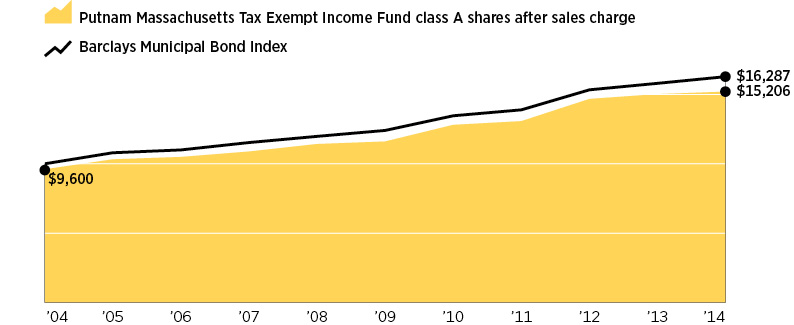
Past performance does not indicate future results. At the end of the same time period, a $10,000 investment in the fund’s class B and class C shares would have been valued at $15,035 and $14,653, respectively, and no contingent deferred sales charges would apply. A $10,000 investment in the fund’s class M shares ($9,675 after sales charge) would have been valued at $14,896. A $10,000 investment in the fund’s class Y shares would have been valued at $16,095.
12 Massachusetts Tax Exempt Income Fund
Fund price and distribution information For the 12-month period ended 5/31/14
Distributions | Class A | Class B | Class C | Class M | Class Y |
Number | 12 | 12 | 12 | 12 | 12 |
Income 1 | $0.318824 | $0.260300 | $0.246015 | $0.293236 | $0.340301 |
Capital gains | | | | | |
Long-term 2 | 0.029800 | 0.029800 | 0.029800 | 0.029800 | 0.029800 |
Short-term 2 | 0.003600 | 0.003600 | 0.003600 | 0.003600 | 0.003600 |
Total | $0.352224 | $0.293700 | $0.279415 | $0.326636 | $0.373701 |
Share value | Before
sales charge | After
sales charge | Net asset
value | Net asset
value | Before
sales charge | After
sales charge | Net asset
value |
5/31/13 | $9.95 | $10.36 | $9.94 | $9.97 | $9.95 | $10.28 | $9.97 |
5/31/14 | 9.70 | 10.10 | 9.69 | 9.72 | 9.70 | 10.03 | 9.72 |
Current rate (end of period) | Before
sales charge | After
sales charge | Net asset
value | Net asset
value | Before
sales charge | After
sales charge | Net asset
value |
Current dividend rate 3 | 3.27% | 3.14% | 2.65% | 2.49% | 3.00% | 2.90% | 3.49% |
Taxable equivalent 4 | 6.10 | 5.85 | 4.94 | 4.64 | 5.59 | 5.41 | 6.51 |
Current 30-day SEC yield 5 | N/A | 2.26 | 1.74 | 1.59 | N/A | 2.02 | 2.58 |
Taxable equivalent 4 | N/A | 4.21 | 3.24 | 2.96 | N/A | 3.77 | 4.81 |
The classification of distributions, if any, is an estimate. Before-sales-charge share value and current dividend rate for class A and M shares, if applicable, do not take into account any sales charge levied at the time of purchase. After-sales-charge share value, current dividend rate, and current 30-day SEC yield, if applicable, are calculated assuming that the maximum sales charge (4.00% for class A shares and 3.25% for class M shares) was levied at the time of purchase. Final distribution information will appear on your year-end tax forms.
1 For some investors, investment income may be subject to the federal alternative minimum tax.
2 Capital gains, if any, are taxable for federal and, in most cases, state purposes.
3 Most recent distribution, including any return of capital and excluding capital gains, annualized and divided by share price before or after sales charge at period-end.
4 Assumes maximum 46.37% federal and state combined tax rate for 2014. Results for investors subject to lower tax rates would not be as advantageous.
5 Based only on investment income and calculated using the maximum offering price for each share class, in accordance with SEC guidelines.
Massachusetts Tax Exempt Income Fund 13
Fund performance as of most recent calendar quarter Total return for periods ended 6/30/14
| Class A | Class B | Class C | Class M | Class Y |
(inception dates) | (10/23/89) | (7/15/93) | (8/19/03) | (5/12/95) | (1/2/08) |
| Before sales charge | After sales charge | Before CDSC | After CDSC | Before CDSC | After CDSC | Before sales charge | After sales charge | Net
asset value |
Annual average | | | | | | | | | |
(life of fund) | 5.86% | 5.69% | 5.59% | 5.59% | 5.03% | 5.03% | 5.52% | 5.38% | 5.93% |
10 years | 57.66 | 51.35 | 49.82 | 49.82 | 46.01 | 46.01 | 53.41 | 48.43 | 60.24 |
Annual average | 4.66 | 4.23 | 4.13 | 4.13 | 3.86 | 3.86 | 4.37 | 4.03 | 4.83 |
5 years | 32.09 | 26.81 | 28.05 | 26.05 | 27.16 | 27.16 | 30.29 | 26.06 | 33.53 |
Annual average | 5.72 | 4.87 | 5.07 | 4.74 | 4.92 | 4.92 | 5.44 | 4.74 | 5.95 |
3 years | 15.86 | 11.23 | 13.73 | 10.73 | 13.30 | 13.30 | 14.92 | 11.19 | 16.61 |
Annual average | 5.03 | 3.61 | 4.38 | 3.46 | 4.25 | 4.25 | 4.74 | 3.60 | 5.26 |
1 year | 4.94 | 0.74 | 4.29 | –0.71 | 4.12 | 3.12 | 4.65 | 1.25 | 5.06 |
See the discussion following the fund performance table on page 11 for information about the calculation of fund performance.
Your fund’s expenses |
As a mutual fund investor, you pay ongoing expenses, such as management fees, distribution fees (12b-1 fees), and other expenses. Using the following information, you can estimate how these expenses affect your investment and compare them with the expenses of other funds. You may also pay one-time transaction expenses, including sales charges (loads) and redemption fees, which are not shown in this section and would have resulted in higher total expenses. For more information, see your fund’s prospectus or talk to your financial representative. |
Expense ratios
| Class A | Class B | Class C | Class M | Class Y |
Total annual operating expenses for the fiscal year ended 5/31/13 | 0.77% | 1.39% | 1.54% | 1.04% | 0.54% |
Annualized expense ratio for the six-month period ended 5/31/14* | 0.78% | 1.40% | 1.55% | 1.05% | 0.55% |
Fiscal-year expense information in this table is taken from the most recent prospectus, is subject to change, and may differ from that shown for the annualized expense ratio and in the financial highlights of this report.
Expenses are shown as a percentage of average net assets.
*For the fund’s most recent fiscal half year; may differ from expense ratios based on one-year data in the financial highlights.
14 Massachusetts Tax Exempt Income Fund
Expenses per $1,000
The following table shows the expenses you would have paid on a $1,000 investment in the fund from December 1, 2013, to May 31, 2014. It also shows how much a $1,000 investment would be worth at the close of the period, assuming actual returns and expenses.
| Class A | Class B | Class C | Class M | Class Y |
Expenses paid per $1,000*† | $4.00 | $7.17 | $7.94 | $5.39 | $2.82 |
Ending value (after expenses) | $1,058.10 | $1,054.90 | $1,055.00 | $1,057.80 | $1,059.20 |
*Expenses for each share class are calculated using the fund’s annualized expense ratio for each class, which represents the ongoing expenses as a percentage of average net assets for the six months ended 5/31/14. The expense ratio may differ for each share class.
†Expenses are calculated by multiplying the expense ratio by the average account value for the period; then multiplying the result by the number of days in the period; and then dividing that result by the number of days in the year.
Estimate the expenses you paid |
To estimate the ongoing expenses you paid for the six months ended May 31, 2014, use the following calculation method. To find the value of your investment on December 1, 2013, call Putnam at 1-800-225-1581. |

|
Compare expenses using the SEC’s method
The Securities and Exchange Commission (SEC) has established guidelines to help investors assess fund expenses. Per these guidelines, the following table shows your fund’s expenses based on a $1,000 investment, assuming a hypothetical 5% annualized return. You can use this information to compare the ongoing expenses (but not transaction expenses or total costs) of investing in the fund with those of other funds. All mutual fund shareholder reports will provide this information to help you make this comparison. Please note that you cannot use this information to estimate your actual ending account balance and expenses paid during the period.
| Class A | Class B | Class C | Class M | Class Y |
Expenses paid per $1,000*† | $3.93 | $7.04 | $7.80 | $5.29 | $2.77 |
Ending value (after expenses) | $1,021.04 | $1,017.95 | $1,017.20 | $1,019.70 | $1,022.19 |
*Expenses for each share class are calculated using the fund’s annualized expense ratio for each class, which represents the ongoing expenses as a percentage of average net assets for the six months ended 5/31/14. The expense ratio may differ for each share class.
†Expenses are calculated by multiplying the expense ratio by the average account value for the six-month period; then multiplying the result by the number of days in the six-month period; and then dividing that result by the number of days in the year.
Massachusetts Tax Exempt Income Fund 15
Terms and definitions
Important terms
Total return shows how the value of the fund’s shares changed over time, assuming you held the shares through the entire period and reinvested all distributions in the fund.
Before sales charge, or net asset value, is the price, or value, of one share of a mutual fund, without a sales charge. Before-sales-charge figures fluctuate with market conditions, and are calculated by dividing the net assets of each class of shares by the number of outstanding shares in the class.
After sales charge is the price of a mutual fund share plus the maximum sales charge levied at the time of purchase. After-sales-charge performance figures shown here assume the 4.00% maximum sales charge for class A shares and 3.25% for class M shares.
Contingent deferred sales charge (CDSC) is generally a charge applied at the time of the redemption of class B or C shares and assumes redemption at the end of the period. Your fund’s class B CDSC declines over time from a 5.00% maximum during the first year to 1.00% during the sixth year. After the sixth year, the CDSC no longer applies. The CDSC for class C shares is 1.00% for one year after purchase.
Share classes
Class A shares are generally subject to an initial sales charge and no CDSC (except on certain redemptions of shares bought without an initial sales charge).
Class B shares are not subject to an initial sales charge. They may be subject to a CDSC.
Class C shares are not subject to an initial sales charge and are subject to a CDSC only if the shares are redeemed during the first year.
Class M shares have a lower initial sales charge and a higher 12b-1 fee than class A shares and no CDSC.
Class Y shares are not subject to an initial sales charge or CDSC, and carry no 12b-1 fee. They are generally only available to corporate and institutional clients and clients in other approved programs.
Fixed-income terms
Current rate is the annual rate of return earned from dividends or interest of an investment. Current rate is expressed as a percentage of the price of a security, fund share, or principal investment.
Yield curve is a graph that plots the yields of bonds with equal credit quality against their differing maturity dates, ranging from shortest to longest. It is used as a benchmark for other debt, such as mortgage or bank lending rates.
Comparative indexes
Barclays Municipal Bond Index is an unmanaged index of long-term fixed-rate investment-grade tax-exempt bonds.
Barclays U.S. Aggregate Bond Index is an unmanaged index of U.S. investment-grade fixed-income securities.
BofA Merrill Lynch U.S. 3-Month Treasury Bill Index is an unmanaged index that seeks to measure the performance of U.S. Treasury bills available in the marketplace.
S&P 500 Index is an unmanaged index of common stock performance.
Indexes assume reinvestment of all distributions and do not account for fees. Securities and performance of a fund and an index will differ. You cannot invest directly in an index.
Lipper is a third-party industry-ranking entity that ranks mutual funds. Its rankings
16 Massachusetts Tax Exempt Income Fund
do not reflect sales charges. Lipper rankings are based on total return at net asset value relative to other funds that have similar current investment styles or objectives as determined by Lipper. Lipper may change a fund’s category assignment at its discretion. Lipper category averages reflect performance trends for funds within a category.
Other information for shareholders
Proxy voting
Putnam is committed to managing our mutual funds in the best interests of our shareholders. The Putnam funds’ proxy voting guidelines and procedures, as well as information regarding how your fund voted proxies relating to portfolio securities during the 12-month period ended June 30, 2013, are available in the Individual Investors section of putnam.com, and on the Securities and Exchange Commission (SEC) website, www.sec.gov. If you have questions about finding forms on the SEC’s website, you may call the SEC at 1-800-SEC-0330. You may also obtain the Putnam funds’ proxy voting guidelines and procedures at no charge by calling Putnam’s Shareholder Services at 1-800-225-1581.
Fund portfolio holdings
The fund will file a complete schedule of its portfolio holdings with the SEC for the first and third quarters of each fiscal year on Form N-Q. Shareholders may obtain the fund’s Forms N-Q on the SEC’s website at www.sec.gov. In addition, the fund’s Forms N-Q may be reviewed and copied at the SEC’s Public Reference Room in Washington, D.C. You may call the SEC at 1-800-SEC-0330 for information about the SEC’s website or the operation of the Public Reference Room.
Trustee and employee fund ownership
Putnam employees and members of the Board of Trustees place their faith, confidence, and, most importantly, investment dollars in Putnam mutual funds. As of May 31, 2014, Putnam employees had approximately $466,000,000 and the Trustees had approximately $113,000,000 invested in Putnam mutual funds. These amounts include investments by the Trustees’ and employees’ immediate family members as well as investments through retirement and deferred compensation plans.
Massachusetts Tax Exempt Income Fund 17
Important notice regarding Putnam’s privacy policy
In order to conduct business with our shareholders, we must obtain certain personal information such as account holders’ names, addresses, Social Security numbers, and dates of birth. Using this information, we are able to maintain accurate records of accounts and transactions.
It is our policy to protect the confidentiality of our shareholder information, whether or not a shareholder currently owns shares of our funds. In particular, it is our policy not to sell information about you or your accounts to outside marketing firms. We have safeguards in place designed to prevent unauthorized access to our computer systems and procedures to protect personal information from unauthorized use.
Under certain circumstances, we must share account information with outside vendors who provide services to us, such as mailings and proxy solicitations. In these cases, the service providers enter into confidentiality agreements with us, and we provide only the information necessary to process transactions and perform other services related to your account. Finally, it is our policy to share account information with your financial representative, if you’ve listed one on your Putnam account.
18 Massachusetts Tax Exempt Income Fund
A note about your fund’s auditors
During your fund’s fiscal year, between July 18, 2013, and December 16, 2013, a non-U.S. member firm in PricewaterhouseCoopers LLP’s (“PwC”) global network of firms had an investment in certain non-U.S. funds that became affiliated with Putnam Investments as a result of the acquisition of the funds’ advisor by Putnam’s parent company, Great-West Lifeco Inc. The investment consisted of pension plan assets for the benefit of the member firm’s personnel. This investment is inconsistent with the SEC’s independence rules applicable to auditors. Although upon the disposition of the investment by the member firm on December 16, 2013, PwC and its affiliates took all necessary steps to eliminate this issue, the requirements of the SEC’s independence rules were not met for your fund’s fiscal year because the SEC’s rules require an audit firm to be independent for the entire fiscal year under audit. Based on its knowledge of the facts and its experience with PwC, the Audit and Compliance Committee of your fund’s Board of Trustees concluded that the investment by the PwC member firm would not affect PwC’s ability to render an objective audit opinion to your fund. Based on this conclusion and consideration of the potential risks that the disruption of a change of auditor could present, the Audit and Compliance Committee determined that PwC should continue to act as auditor for your fund.
These sections of the report, as well as the accompanying Notes, preceded by the Report of Independent Registered Public Accounting Firm, constitute the fund’s financial statements.
The fund’s portfolio lists all the fund’s investments and their values as of the last day of the reporting period. Holdings are organized by asset type and industry sector, country, or state to show areas of concentration and diversification.
Statement of assets and liabilities shows how the fund’s net assets and share price are determined. All investment and non-investment assets are added together. Any unpaid expenses and other liabilities are subtracted from this total. The result is divided by the number of shares to determine the net asset value per share, which is calculated separately for each class of shares. (For funds with preferred shares, the amount subtracted from total assets includes the liquidation preference of preferred shares.)
Statement of operations shows the fund’s net investment gain or loss. This is done by first adding up all the fund’s earnings — from dividends and interest income — and subtracting its operating expenses to determine net investment income (or loss). Then, any net gain or loss the fund realized on the sales of its holdings — as well as any unrealized gains or losses over the period — is added to or subtracted from the net investment result to determine the fund’s net gain or loss for the fiscal year.
Statement of changes in net assets shows how the fund’s net assets were affected by the fund’s net investment gain or loss, by distributions to shareholders, and by changes in the number of the fund’s shares. It lists distributions and their sources (net investment income or realized capital gains) over the current reporting period and the most recent fiscal year-end. The distributions listed here may not match the sources listed in the Statement of operations because the distributions are determined on a tax basis and may be paid in a different period from the one in which they were earned.
Financial highlights provide an overview of the fund’s investment results, per-share distributions, expense ratios, net investment income ratios, and portfolio turnover in one summary table, reflecting the five most recent reporting periods. In a semiannual report, the highlights table also includes the current reporting period.
Massachusetts Tax Exempt Income Fund 19
Report of Independent Registered Public Accounting Firm
To the Trustees and Shareholders of
Putnam Massachusetts Tax Exempt Income Fund:
In our opinion, the accompanying statement of assets and liabilities, including the portfolio, and the related statements of operations and of changes in net assets and the financial highlights present fairly, in all material respects, the financial position of Putnam Massachusetts Tax Exempt Income Fund (the “fund”) at May 31, 2014, and the results of its operations, the changes in its net assets and the financial highlights for each of the periods indicated, in conformity with accounting principles generally accepted in the United States of America. These financial statements and financial highlights (hereafter referred to as “financial statements”) are the responsibility of the fund’s management. Our responsibility is to express an opinion on these financial statements based on our audits. We conducted our audits of these financial statements in accordance with the standards of the Public Company Accounting Oversight Board (United States). Those standards require that we plan and perform the audit to obtain reasonable assurance about whether the financial statements are free of material misstatement. An audit includes examining, on a test basis, evidence supporting the amounts and disclosures in the financial statements, assessing the accounting principles used and significant estimates made by management, and evaluating the overall financial statement presentation. We believe that our audits, which included confirmation of investments owned at May 31, 2014 by correspondence with the custodian, provide a reasonable basis for our opinion.
PricewaterhouseCoopers LLP
Boston, Massachusetts
July 10, 2014
20 Massachusetts Tax Exempt Income Fund
The fund’s portfolio 5/31/14
Key to holding’s abbreviations
AGM Assured Guaranty Municipal Corporation
AGO Assured Guaranty, Ltd.
AMBAC AMBAC Indemnity Corporation
FGIC Financial Guaranty Insurance Company
FRB Floating Rate Bonds: the rate shown is the current interest rate at the close of the reporting period
FRN Floating Rate Notes: the rate shown is the current interest rate at the close of the reporting period
G.O. Bonds General Obligation Bonds
NATL National Public Finance Guarantee Corp.
SGI Syncora Guarantee, Inc.
VRDN Variable Rate Demand Notes, which are floating-rate securities with long-term maturities that carry coupons that reset and are payable upon demand either daily, weekly or monthly. The rate shown is the current interest rate at the close of the reporting period.
| MUNICIPAL BONDS AND NOTES (99.0%)* | Rating** | | Principal
amount | Value |
| California (0.5%) | | | | |
| CA State G.O. Bonds, 5s, 2/1/38 | A1 | | $1,500,000 | $1,652,610 |
| | | | | 1,652,610 |
| Guam (1.3%) | | | | |
| Territory of GU, Rev. Bonds, Ser. A, 5 3/8s, 12/1/24 | BBB+ | | 1,000,000 | 1,084,100 |
| Territory of GU, Bus. Privilege Tax Rev. Bonds, Ser. A, 5s, 1/1/31 | A | | 1,650,000 | 1,727,204 |
| Territory of GU, Govt. Wtr. Wks. Auth. Wtr. & Waste Wtr. Syst. Rev. Bonds, 5 5/8s, 7/1/40 | A– | | 600,000 | 629,010 |
| Territory of GU, Pwr. Auth. Rev. Bonds, Ser. A | | | | |
| 5 1/2s, 10/1/40 | BBB | | 500,000 | 540,935 |
| 5s, 10/1/34 | BBB | | 200,000 | 211,132 |
| | | | | 4,192,381 |
| Indiana (0.7%) | | | | |
| IN State Fin. Auth. VRDN, Ser. A-2, 0.09s, 2/1/37 | VMIG1 | | 2,000,000 | 2,000,000 |
| | | | | 2,000,000 |
| Massachusetts (91.5%) | | | | |
| Boston, Indl. Dev. Fin. Auth. Swr. Fac. Rev. Bonds (Harbor Elec. Energy Co.), 7 3/8s, 5/15/15 | Aa3 | | 1,345,000 | 1,351,954 |
| Boston, Wtr. & Swr. Comm. Rev. Bonds, Ser. A, 5s, 11/1/30 | Aa1 | | 500,000 | 577,435 |
| Hampden & Wilbraham, Regl. School Dist. G.O. Bonds, 5s, 2/15/41 | Aa3 | | 2,000,000 | 2,146,740 |
| Holyoke G.O. Bonds, 5s, 9/1/29 | Aa2 | | 770,000 | 872,656 |
| Lowell, G.O. Bonds, Ser. A, SGI, 5s, 9/15/22 | Aa2 | | 1,750,000 | 1,901,603 |
| MA Bay Trans. Auth. Rev. Bonds (Assmt.), Ser. A, 5 1/4s, 7/1/31 | AAA | | 1,000,000 | 1,261,990 |
| MA Bay Trans. Auth. Sales Tax Rev. Bonds | | | | |
| Ser. C, 5 1/2s, 7/1/16 | AAA | | 2,855,000 | 3,161,227 |
| Ser. C, 5 1/2s, 7/1/16 (Escrowed to maturity) | AAA/P | | 120,000 | 132,818 |
| Ser. C, 5 1/4s, 7/1/23 | AAA | | 1,335,000 | 1,670,779 |
| Ser. A, 5s, 7/1/31 | AAA | | 3,390,000 | 4,167,666 |
| MA Dev. Fin. Agcy. Rev. Bonds (Groves), Ser. A, 7 7/8s, 6/1/44 F | CCC/P | | 1,072,623 | 67,575 |
| MA Edl. Fin. Auth. Rev. Bonds, Ser. B, 5.7s, 1/1/31 | AA | | 1,700,000 | 1,825,783 |
Massachusetts Tax Exempt Income Fund 21
| MUNICIPAL BONDS AND NOTES (99.0%)* cont. | Rating** | | Principal
amount | Value |
| Massachusetts cont. | | | | |
| MA State G.O. Bonds | | | | |
| Ser. C, AMBAC, 5s, 8/1/37 | Aa1 | | $2,000,000 | $2,193,660 |
| (Construction Loan), Ser. A, 5s, 8/1/27 | Aa1 | | 2,000,000 | 2,272,460 |
| Ser. D, 5s, 10/1/26 | Aa1 | | 2,000,000 | 2,384,340 |
| MA State Rev. Bonds, 5s, 6/15/22 | AAA | | 3,500,000 | 4,287,010 |
| MA State VRDN (Construction Loan), Ser. A, 0.07s, 3/1/26 | VMIG1 | | 2,200,000 | 2,200,000 |
| MA State Clean Energy Cooperative Corp. Rev. Bonds | | | | |
| (Muni. Ltg. Plant Coop.), 5s, 7/1/32 | A1 | | 1,000,000 | 1,120,690 |
| (Muni. Lighting Plant), 5s, 7/1/28 | A1 | | 1,000,000 | 1,152,690 |
| MA State College Bldg. Auth. Rev. Bonds | | | | |
| Ser. B, SGI, 5 1/2s, 5/1/28 | Aa2 | | 4,000,000 | 5,001,640 |
| Ser. B, 5s, 5/1/43 | Aa2 | | 3,100,000 | 3,420,974 |
| Ser. B, 5s, 5/1/37 | Aa2 | | 1,500,000 | 1,671,765 |
| Ser. A, 5s, 5/1/36 | Aa2 | | 2,850,000 | 3,212,207 |
| Ser. A, AGO, 5s, 5/1/28 | Aa2 | | 2,270,000 | 2,523,854 |
| MA State Dept. Trans. Rev. Bonds
(Metro Hwy. Syst.), Ser. B | | | | |
| 5s, 1/1/37 | A+ | | 2,250,000 | 2,390,243 |
| 5s, 1/1/32 | A+ | | 2,775,000 | 2,989,924 |
| MA State Dev. Fin. Agcy. Rev. Bonds | | | | |
| (Sabis Intl.), Ser. A, 8s, 4/15/39 | BBB | | 775,000 | 918,375 |
| (Tufts Med. Ctr.), Ser. I, 7 1/4s, 1/1/32 | BBB | | 2,000,000 | 2,416,140 |
| (Linden Ponds, Inc. Fac.), Ser. A-1, 6 1/4s, 11/15/46 | B–/P | | 1,347,179 | 1,126,296 |
| (Linden Ponds, Inc. Fac.), Ser. A-1, 6 1/4s, 11/15/39 | B–/P | | 423,099 | 370,279 |
| (Loomis Cmntys.), Ser. A, 6s, 1/1/33 | BBB– | | 300,000 | 314,940 |
| (WGBH Edl. Foundation), Ser. A, AMBAC, 5 3/4s, 1/1/42 | A | | 5,000,000 | 6,130,250 |
| (Hampshire College), 5.7s, 10/1/34 (Prerefunded 10/1/14) | Baa2 | | 1,315,000 | 1,321,536 |
| (Milford Regl. Med. Ctr.), Ser. F, 5 5/8s, 7/15/36 | Baa3 | | 500,000 | 530,510 |
| (Hampshire College), 5 5/8s, 10/1/24 (Prerefunded 10/1/14) | Baa2 | | 1,000,000 | 1,007,310 |
| (Linden Ponds, Inc. Fac.), Ser. A-2, 5 1/2s, 11/15/46 | B–/P | | 94,100 | 70,228 |
| (Emerson College), Ser. A, 5 1/2s, 1/1/30 | Baa1 | | 900,000 | 1,002,474 |
| (Berklee College of Music), 5 1/4s, 10/1/41 | A2 | | 1,500,000 | 1,646,895 |
| (New England Conservatory of Music), 5 1/4s, 7/1/38 | Baa1 | | 3,000,000 | 3,146,520 |
| (Simmons College), Ser. H, SGI, 5 1/4s, 10/1/33 | Baa1 | | 4,000,000 | 4,574,840 |
| (Lesley U.), Ser. B-1, AGM, 5 1/4s, 7/1/33 | AA | | 2,000,000 | 2,220,260 |
| (Wheelock College), Ser. C, 5 1/4s, 10/1/29 | BBB | | 2,400,000 | 2,578,224 |
| (Carleton-Willard Village), 5 1/4s, 12/1/25 | A– | | 700,000 | 749,168 |
| (Suffolk U.), 5 1/8s, 7/1/40 | Baa2 | | 1,500,000 | 1,543,680 |
| (Emerson College), Ser. A, 5s, 1/1/40 | Baa1 | | 3,400,000 | 3,545,860 |
| (Brandeis U.), Ser. N, 5s, 10/1/39 | A1 | | 450,000 | 483,206 |
22 Massachusetts Tax Exempt Income Fund
| MUNICIPAL BONDS AND NOTES (99.0%)* cont. | Rating** | | Principal
amount | Value |
| Massachusetts cont. | | | | |
| MA State Dev. Fin. Agcy. Rev. Bonds | | | | |
| (Franklin W. Olin College), Ser. E, 5s, 11/1/38 | A+ | | $1,000,000 | $1,095,800 |
| (Boston College), Ser. P, 5s, 7/1/38 | Aa3 | | 2,000,000 | 2,136,660 |
| (Lowell Gen. Hosp.), Ser. G, 5s, 7/1/37 | BBB+ | | 1,630,000 | 1,701,231 |
| (Brandeis U.), Ser. 0-1, 5s, 10/1/35 | A1 | | 1,000,000 | 1,113,330 |
| (Northeastern U.), 5s, 10/1/31 | A2 | | 500,000 | 552,595 |
| (MA College Pharmacy Allied), Ser. E, AGO, 5s, 7/1/31 | AA | | 2,000,000 | 2,111,200 |
| (Partners Hlth. Care Syst.), Ser. L, 5s, 7/1/31 | Aa2 | | 4,495,000 | 5,036,782 |
| (Boston U.), Ser. V-1, 5s, 10/1/29 | A1 | | 2,000,000 | 2,273,420 |
| (Boston College), Ser. Q-1, 5s, 7/1/29 | Aa3 | | 1,050,000 | 1,166,424 |
| (Mount Holyoke College), 5s, 7/1/28 | Aa3 | | 3,000,000 | 3,318,240 |
| (Holy Cross College), Ser. B, 5s, 9/1/25 | Aa3 | | 1,500,000 | 1,698,420 |
| (MA College of Pharmacy & Allied Hlth. Science), Ser. F, 5s, 7/1/25 | A+ | | 650,000 | 748,137 |
| (MA College of Pharmacy & Allied Hlth. Science), Ser. F, 5s, 7/1/23 | A+ | | 125,000 | 147,890 |
| (First Mtge. — Orchard Cove), 5s, 10/1/19 | BB/P | | 550,000 | 561,534 |
| (First Mtge. — Orchard Cove), 5s, 10/1/18 | BB/P | | 515,000 | 525,872 |
| (Linden Ponds, Inc. Fac.), Ser. B, zero %, 11/15/56 | B–/P | | 468,041 | 3,464 |
| (WGBH Edl. Foundation), Ser. B, AGO, zero %, 1/1/29 | AA | | 2,000,000 | 1,192,420 |
| (WGBH Edl. Foundation), Ser. B, AGO, zero %, 1/1/28 | AA | | 2,000,000 | 1,258,780 |
| MA State Dev. Fin. Agcy. Solid Waste Disp. FRB | | | | |
| (Dominion Energy Brayton), Ser. 1, 5 3/4s, 12/1/42 (Prerefunded 5/1/19) | BBB+ | | 1,700,000 | 2,070,328 |
| (Dominion Energy Brayton Point), 5s, 2/1/36 (Prerefunded 8/1/16) | BBB+ | | 1,000,000 | 1,094,660 |
| MA State Edl. Fin. Auth. Rev. Bonds | | | | |
| Ser. J, 5 5/8s, 7/1/28 | AA | | 955,000 | 1,039,346 |
| (Ed. Loan Issue 1), 5s, 1/1/27 ## | AA– | | 1,200,000 | 1,315,644 |
| MA State Hlth. & Edl. Fac. Auth. Rev. Bonds | | | | |
| (Quincy Med. Ctr.), Ser. A, 6 1/2s, 1/15/38 (In default) † | D/P | | 194,574 | 19 |
| (Harvard U.), Ser. N, 6 1/4s, 4/1/20 | AAA | | 3,000,000 | 3,811,110 |
| (Suffolk U.), Ser. A, 5 3/4s, 7/1/39 | Baa2 | | 3,000,000 | 3,257,520 |
| (Springfield College), 5 5/8s, 10/15/40 | Baa1 | | 2,000,000 | 2,127,600 |
| (Harvard U.), Ser. A, 5 1/2s, 11/15/36 | Aaa | | 2,185,000 | 2,562,721 |
| (Milton Hosp.), Ser. D, 5 3/8s, 7/1/35 | BB+ | | 1,065,000 | 1,069,303 |
| (Jordan Hosp.), Ser. D, 5 3/8s, 10/1/28 | B+ | | 3,000,000 | 3,000,240 |
| (Care Group), Ser. B-1, NATL, 5 3/8s, 2/1/27 | AA– | | 1,030,000 | 1,126,192 |
| (Boston College), Ser. K, 5 3/8s, 6/1/14 | Aa3 | | 810,000 | 810,000 |
| (Lesley U.), Ser. A, AGO, 5 1/4s, 7/1/39 | AA | | 1,000,000 | 1,102,200 |
| (Winchester Hosp.), 5 1/4s, 7/1/38 | BBB+ | | 3,225,000 | 3,378,381 |
| (Lahey Clinic Med. Ctr.), Ser. D, 5 1/4s, 8/15/28 | A+ | | 3,000,000 | 3,216,510 |
| (Dana-Farber Cancer Inst.), Ser. K, 5 1/4s, 12/1/27 | A1 | | 1,500,000 | 1,660,500 |
Massachusetts Tax Exempt Income Fund 23
| MUNICIPAL BONDS AND NOTES (99.0%)* cont. | Rating** | | Principal
amount | Value |
| Massachusetts cont. | | | | |
| MA State Hlth. & Edl. Fac. Auth. Rev. Bonds | | | | |
| (MA Inst. of Tech.), Ser. I-1, 5.2s, 1/1/28 | Aaa | | $5,000,000 | $6,432,450 |
| (Care Group), Ser. E-1, 5 1/8s, 7/1/38 | A3 | | 1,000,000 | 1,057,680 |
| (Fisher College), Ser. A, 5 1/8s, 4/1/37 | BBB– | | 755,000 | 761,357 |
| (Lowell Gen. Hosp.), Ser. C, 5 1/8s, 7/1/35 | BBB+ | | 725,000 | 758,234 |
| (Wheaton Coll.), Ser. F, 5s, 1/1/41 | A2 | | 2,000,000 | 2,086,800 |
| (Partners Hlth. Care Syst.), Ser. J-1, 5s, 7/1/39 | Aa2 | | 1,500,000 | 1,646,880 |
| (Southcoast Hlth. Oblig.), Ser. D, 5s, 7/1/39 | A2 | | 1,500,000 | 1,571,040 |
| (Harvard U.), Ser. B, 5s, 10/1/38 | Aaa | | 500,000 | 553,625 |
| (MA Inst. of Tech.), Ser. A, 5s, 7/1/38 | Aaa | | 2,250,000 | 2,473,650 |
| (Berklee College of Music), Ser. A, 5s, 10/1/37 | A2 | | 2,750,000 | 2,952,483 |
| (Milford Regl. Med.), Ser. E, 5s, 7/15/37 | Baa3 | | 850,000 | 853,842 |
| (Sterling & Francine Clark), Ser. A, 5s, 7/1/36 | AA | | 1,000,000 | 1,057,100 |
| (Northeastern U.), Ser. A, 5s, 10/1/35 | A2 | | 300,000 | 320,403 |
| (Harvard U.), 5s, 7/15/35 | Aaa | | 2,750,000 | 2,868,690 |
| (Northeastern U.), Ser. T-1, 5s, 10/1/30 | A2 | | 1,000,000 | 1,112,050 |
| (Northeastern U.), Ser. T-2, 5s, 10/1/30 | A2 | | 2,000,000 | 2,205,820 |
| (Care Group), Ser. E-1, 5s, 7/1/28 | A3 | | 1,730,000 | 1,852,138 |
| (Northeastern U.), Ser. R, 5s, 10/1/26 | A2 | | 1,165,000 | 1,295,783 |
| (Worcester City Campus Corp.), Ser. E, FGIC, NATL, 5s, 10/1/26 | AA– | | 2,000,000 | 2,137,000 |
| (Milford Regl. Med.), Ser. E, 5s, 7/15/22 | Baa3 | | 1,800,000 | 1,880,010 |
| (Fisher College), Ser. A, 5s, 4/1/22 | BBB– | | 1,110,000 | 1,163,513 |
| MA State Hlth. & Edl. Fac. Auth. VRDN | | | | |
| (Baystate Med. Ctr.), Ser. J-2, 0.07s, 7/1/44 | VMIG1 | | 800,000 | 800,000 |
| (Tufts U.), Ser. N-2, 0.06s, 8/15/34 | VMIG1 | | 2,200,000 | 2,200,000 |
| (Wellesley College), Ser. I, 0.05s, 7/1/39 | VMIG1 | | 3,095,000 | 3,095,000 |
| MA State Hsg. Fin. Agcy. FRB (Single Fam. Hsg.), Ser. 126, 4.7s, 6/1/38 | Aa2 | | 930,000 | 933,506 |
| MA State Hsg. Fin. Agcy. Rev. Bonds | | | | |
| Ser. C, 5.35s, 12/1/42 | Aa3 | | 1,500,000 | 1,549,605 |
| Ser. A, 5.1s, 12/1/30 | Aa3 | | 2,100,000 | 2,201,556 |
| Ser. D, 5.05s, 6/1/40 | Aa3 | | 1,560,000 | 1,627,002 |
| Ser. 157, 4.35s, 12/1/27 | Aa2 | | 1,160,000 | 1,197,433 |
| Ser. SF-169, 4s, 12/1/44 | Aa2 | | 1,800,000 | 1,956,708 |
| Ser. 160, 3 3/4s, 6/1/34 | Aa2 | | 755,000 | 783,569 |
| Ser. A, 3 1/2s, 12/1/31 | Aa3 | | 2,000,000 | 1,966,540 |
| Ser. A, 3 1/4s, 12/1/27 | Aa3 | | 1,870,000 | 1,831,908 |
| MA State Indl. Fin. Agcy. Rev. Bonds (1st Mtge. Berkshire Retirement), Ser. A, 6 5/8s, 7/1/16 | BBB | | 925,000 | 928,987 |
| MA State Port Auth. Rev. Bonds | | | | |
| Ser. A, 5s, 7/1/34 | Aa3 | | 3,500,000 | 3,833,095 |
| Ser. C, AGM, 5s, 7/1/27 | AA | | 5,000,000 | 5,349,300 |
| Ser. A, AMBAC, 5s, 7/1/26 | Aa3 | | 3,000,000 | 3,146,880 |
| MA State Port Auth. Special Fac. Rev. Bonds | | | | |
| (Conrac), Ser. A, 5 1/8s, 7/1/41 | A | | 1,765,000 | 1,898,628 |
| (BOSFUEL), FGIC, NATL, 5s, 7/1/27 | AA– | | 2,500,000 | 2,647,275 |
24 Massachusetts Tax Exempt Income Fund
| MUNICIPAL BONDS AND NOTES (99.0%)* cont. | Rating** | | Principal
amount | Value |
| Massachusetts cont. | | | | |
| MA State School Bldg. Auth. Dedicated Sales Tax Rev. Bonds, Ser. A | | | | |
| 5s, 8/15/30 | AA+ | | $3,500,000 | $4,035,430 |
| AGM, 5s, 8/15/26 (Prerefunded 8/15/15) | AA+ | | 4,000,000 | 4,229,480 |
| MA State School Bldg. Auth. Sr. Sales Tax Rev. Bonds, Ser. B | | | | |
| 5s, 10/15/41 | AA+ | | 3,500,000 | 3,871,560 |
| 5s, 10/15/35 | AA+ | | 1,000,000 | 1,121,400 |
| 5s, 8/15/30 | AA+ | | 4,000,000 | 4,611,920 |
| MA State Trans. Fund Rev. Bonds (Accelerated Bridge Program), 5s, 6/1/43 | Aaa | | 2,100,000 | 2,325,414 |
| MA State Wtr. Poll. Abatement Trust Rev. Bonds | | | | |
| Ser. 14, 5s, 8/1/32 | Aaa | | 4,000,000 | 4,503,720 |
| Ser. 13, 5s, 8/1/26 | Aaa | | 1,000,000 | 1,124,710 |
| MA State Wtr. Resource Auth. Rev. Bonds | | | | |
| Ser. A, 6 1/2s, 7/15/19 (Escrowed to maturity) | Aa1 | | 4,775,000 | 5,427,838 |
| Ser. C, 5 1/4s, 8/1/42 | Aa1 | | 3,500,000 | 3,946,075 |
| Ser. A, NATL, 5s, 8/1/29 (Prerefunded 8/1/14) | Aa1 | | 4,000,000 | 4,030,680 |
| Ser. A, NATL, 5s, 8/1/29 | Aa1 | | 3,225,000 | 3,523,764 |
| Ser. B, AMBAC, 5s, 8/1/26 | Aa1 | | 2,000,000 | 2,285,480 |
| Metro. Boston, Trans. Pkg. Corp. Rev. Bonds, 5 1/4s, 7/1/36 | A1 | | 1,500,000 | 1,681,170 |
| Milford, G.O. Bonds, AGM, 5 1/8s, 12/15/24 | Aa2 | | 2,475,000 | 2,766,976 |
| Newburyport, G.O. Bonds (Muni. Purpose Loan), 4s, 1/15/24 | AA+ | | 1,280,000 | 1,445,926 |
| North Reading, G.O. Bonds, 5s, 5/15/35 | Aa2 | | 3,750,000 | 4,225,913 |
| Norwell, G.O. Bonds, AMBAC, 5s, 2/15/25 (Prerefunded 2/15/15) | AAA | | 1,000,000 | 1,043,550 |
| U. of MA Bldg. Auth. Rev. Bonds, Ser. 2, 5s, 11/1/39 | Aa2 | | 2,500,000 | 2,800,025 |
| Worcester, G.O. Bonds (Muni. Purpose Loan), 4s, 11/1/23 | Aa3 | | 3,050,000 | 3,306,139 |
| | | | | 288,235,857 |
| Mississippi (0.8%) | | | | |
| MS State Bus. Fin. Commission Gulf Opportunity Zone VRDN (Chevron USA, Inc.), Ser. F, 0.06s, 12/1/30 | VMIG1 | | 2,500,000 | 2,500,000 |
| | | | | 2,500,000 |
| Puerto Rico (3.7%) | | | | |
| Children’s Trust Fund Tobacco Settlement (The) Rev. Bonds | | | | |
| 5 1/2s, 5/15/39 | Ba1 | | 1,800,000 | 1,666,764 |
| 5 3/8s, 5/15/33 | BBB | | 1,660,000 | 1,660,133 |
| Cmnwlth. of PR, G.O. Bonds, Ser. A | | | | |
| 5 1/2s, 7/1/39 | BB+ | | 1,000,000 | 715,020 |
| 5 1/4s, 7/1/26 | BB+ | | 1,620,000 | 1,234,262 |
| 5 1/8s, 7/1/37 | BB+ | | 750,000 | 528,758 |
| Cmnwlth. of PR, Elec. Pwr. Auth. Rev. Bonds | | | | |
| Ser. CCC, 5s, 7/1/28 | BBB | | 1,000,000 | 632,550 |
| Ser. TT, 5s, 7/1/27 | BBB | | 1,000,000 | 633,200 |
Massachusetts Tax Exempt Income Fund 25
| MUNICIPAL BONDS AND NOTES (99.0%)* cont. | Rating** | | Principal
amount | Value |
| Puerto Rico cont. | | | | |
| Cmnwlth. of PR, Hwy. & Trans. Auth. Rev. Bonds FRN, Ser. AA-2, 5.3s, 7/1/35 | Ba1 | | $525,000 | $407,269 |
| Cmnwlth. of PR, Sales Tax Fin. Corp. Rev. Bonds | | | | |
| Ser. A, 5 1/2s, 8/1/37 | A+ | | 1,000,000 | 818,360 |
| Ser. C, 5 1/4s, 8/1/41 | A+ | | 2,990,000 | 2,310,134 |
| Ser. C, 5 1/4s, 8/1/40 | AA– | | 1,250,000 | 1,119,363 |
| | | | | 11,725,813 |
| Virgin Islands (0.5%) | | | | |
| VI Pub. Fin. Auth. Rev. Bonds, Ser. A | | | | |
| 6s, 10/1/39 | Baa3 | | 600,000 | 626,274 |
| 5s, 10/1/25 | Baa2 | | 850,000 | 944,650 |
| |
1,570,924
|
| TOTAL INVESTMENTS | |
| Total investments (cost $294,846,915) | $311,877,585 |
| Notes to the fund’s portfolio |
| Unless noted otherwise, the notes to the fund’s portfolio are for the close of the fund’s reporting period, which ran from June 1, 2013 through May 31, 2014 (the reporting period). Within the following notes to the portfolio, references to “ASC 820” represent Accounting Standards Codification 820 Fair Value Measurements and Disclosures and references to “OTC”, if any, represent over-the-counter. |
* | Percentages indicated are based on net assets of $314,988,769. |
** | The Moody’s, Standard & Poor’s or Fitch ratings indicated are believed to be the most recent ratings available at the close of the reporting period for the securities listed. Ratings are generally ascribed to securities at the time of issuance. While the agencies may from time to time revise such ratings, they undertake no obligation to do so, and the ratings do not necessarily represent what the agencies would ascribe to these securities at the close of the reporting period. Securities rated by Putnam are indicated by “/P.” The rating of an insured security represents what is believed to be the most recent rating of the insurer’s claims-paying ability available at the close of the reporting period, if higher than the rating of the direct issuer of the bond, and does not reflect any subsequent changes. Ratings are not covered by the Report of Independent Registered Public Accounting Firm. Security ratings are defined in the Statement of Additional Information. |
† | Non-income-producing security. |
## | Forward commitment, in part or in entirety (Note 1). |
F | Security is valued at fair value following procedures approved by the Trustees. Securities may be classified as Level 2 or Level 3 for ASC 820 based on the securities’ valuation inputs. |
| The rates shown on Mandatory Put Bonds are the current interest rates at the close of the reporting period. |
| The dates shown parenthetically on Mandatory Put Bonds represent the next mandatory put dates. |
| The dates shown parenthetically on prerefunded bonds represent the next prerefunding dates. |
| The dates shown on debt obligations are the original maturity dates. |
| The fund had the following sector concentrations greater than 10% at the close of the reporting period (as a percentage of net assets): |
| Education | 32.4% |
| Health care | 12.2 |
| Tax bonds | 11.1 |
26 Massachusetts Tax Exempt Income Fund
| ASC 820 establishes a three-level hierarchy for disclosure of fair value measurements. The valuation hierarchy is based upon the transparency of inputs to the valuation of the fund’s investments. The three levels are defined as follows: |
| Level 1: Valuations based on quoted prices for identical securities in active markets. |
| Level 2: Valuations based on quoted prices in markets that are not active or for which all significant inputs are observable, either directly or indirectly. |
| Level 3: Valuations based on inputs that are unobservable and significant to the fair value measurement. |
| The following is a summary of the inputs used to value the fund’s net assets as of the close of the reporting period: |
| | Valuation inputs |
| Investments in securities: | Level 1 | Level 2 | Level 3 |
| Municipal bonds and notes | $— | $311,810,010 | $67,575 |
| Totals by level | $— | $311,810,010 | $67,575 |
| At the start and close of the reporting period, Level 3 investments in securities were not considered a significant portion of the fund’s portfolio. |
The accompanying notes are an integral part of these financial statements.
Massachusetts Tax Exempt Income Fund 27
| Statement of assets and liabilities 5/31/14 | |
| ASSETS | |
| Investment in securities, at value (Note 1): | |
| Unaffiliated issuers (identified cost $294,846,915) | $311,877,585 |
| Cash | 338,435 |
| Interest and other receivables | 4,512,673 |
| Receivable for shares of the fund sold | 517,710 |
| Receivable for investments sold | 1,170,503 |
| Prepaid assets | 8,650 |
| Total assets | 318,425,556 |
| LIABILITIES | |
| Payable for purchases of delayed delivery securities (Note 1) | 1,294,848 |
| Payable for shares of the fund repurchased | 1,488,852 |
| Payable for compensation of Manager (Note 2) | 115,169 |
| Payable for custodian fees (Note 2) | 3,766 |
| Payable for investor servicing fees (Note 2) | 25,634 |
| Payable for Trustee compensation and expenses (Note 2) | 102,600 |
| Payable for administrative services (Note 2) | 920 |
| Payable for distribution fees (Note 2) | 125,897 |
| Distributions payable to shareholders | 181,516 |
| Other accrued expenses | 97,585 |
| Total liabilities | 3,436,787 |
| Net assets | $314,988,769 |
| | |
| REPRESENTED BY | |
| Paid-in capital (Unlimited shares authorized) (Notes 1 and 4) | $302,515,792 |
| Undistributed net investment income (Note 1) | 436,971 |
| Accumulated net realized loss on investments (Note 1) | (4,994,664) |
| Net unrealized appreciation of investments | 17,030,670 |
| Total — Representing net assets applicable to capital shares outstanding | $314,988,769 |
| COMPUTATION OF NET ASSET VALUE AND OFFERING PRICE | |
| Net asset value and redemption price per class A share ($254,367,648 divided by 26,228,966 shares) | $9.70 |
| Offering price per class A share (100/96.00 of $9.70)* | $10.10 |
| Net asset value and offering price per class B share ($3,346,729 divided by 345,497 shares)** | $9.69 |
| Net asset value and offering price per class C share ($31,065,561 divided by 3,197,660 shares)** | $9.72 |
| Net asset value and redemption price per class M share ($3,101,813 divided by 319,865 shares) | $9.70 |
| Offering price per class M share (100/96.75 of $9.70)† | $10.03 |
| Net asset value, offering price and redemption price per class Y share ($23,107,018 divided by 2,376,749 shares) | $9.72 |
* | On single retail sales of less than $100,000. On sales of $100,000 or more the offering price is reduced. |
** | Redemption price per share is equal to net asset value less any applicable contingent deferred sales charge. |
† | On single retail sales of less than $50,000. On sales of $50,000 or more the offering price is reduced. |
The accompanying notes are an integral part of these financial statements.
28 Massachusetts Tax Exempt Income Fund
| Statement of operations Year ended 5/31/14 | |
| INTEREST INCOME | $14,095,824 |
| | |
| EXPENSES | |
| Compensation of Manager (Note 2) | $1,466,973 |
| Investor servicing fees (Note 2) | 166,794 |
| Custodian fees (Note 2) | 9,012 |
| Trustee compensation and expenses (Note 2) | 24,828 |
| Distribution fees (Note 2) | 1,012,481 |
| Administrative services (Note 2) | 8,426 |
| Other | 156,066 |
| Total expenses | 2,844,580 |
| Expense reduction (Note 2) | (1,074) |
| Net expenses | 2,843,506 |
| Net investment income | 11,252,318 |
| | |
| Net realized loss on investments (Notes 1 and 3) | (4,901,044) |
| Net realized loss on futures contracts (Note 1) | (22,452) |
| Net unrealized depreciation of investments during the year | (7,971,694) |
| Net loss on investments | (12,895,190) |
| Net decrease in net assets resulting from operations | $(1,642,872) |
The accompanying notes are an integral part of these financial statements.
Massachusetts Tax Exempt Income Fund 29
| Statement of changes in net assets | | |
| INCREASE (DECREASE) IN NET ASSETS | Year ended 5/31/14 | Year ended 5/31/13 |
| Operations: | | |
| Net investment income | $11,252,318 | $12,566,404 |
| Net realized gain (loss) on investments | (4,923,496) | 1,062,848 |
| Net unrealized depreciation of investments | (7,971,694) | (4,752,221) |
| Net increase (decrease) in net assets resulting from operations | (1,642,872) | 8,877,031 |
| Distributions to shareholders (Note 1): | | |
| From ordinary income | | |
| Taxable net investment income | | |
| Class A | (55,371) | (328,542) |
| Class B | (735) | (3,748) |
| Class C | (7,188) | (41,095) |
| Class M | (665) | (3,820) |
| Class Y | (4,809) | (28,864) |
| Net realized short-term gain on investments | | |
| Class A | (94,921) | (118,835) |
| Class B | (1,260) | (1,356) |
| Class C | (12,322) | (14,864) |
| Class M | (1,140) | (1,381) |
| Class Y | (8,245) | (10,440) |
| From tax-exempt net investment income | | |
| Class A | (9,076,653) | (10,296,688) |
| Class B | (95,970) | (99,072) |
| Class C | (900,723) | (978,068) |
| Class M | (100,243) | (115,869) |
| Class Y | (886,665) | (982,320) |
| From net realized long-term gain on investments | | |
| Class A | (785,738) | (202,716) |
| Class B | (10,431) | (2,312) |
| Class C | (102,000) | (25,357) |
| Class M | (9,440) | (2,357) |
| Class Y | (68,248) | (17,810) |
| Increase (decrease) from capital share transactions (Note 4) | (97,636,149) | 73,522,728 |
| Total increase (decrease) in net assets | (111,501,788) | 69,124,245 |
| NET ASSETS | | |
| Beginning of year | 426,490,557 | 357,366,312 |
| End of year (including undistributed net investment income of $436,971 and $179,713, respectively) | $314,988,769 | $426,490,557 |
The accompanying notes are an integral part of these financial statements.
30 Massachusetts Tax Exempt Income Fund
This page left blank intentionally.
Massachusetts Tax Exempt Income Fund 31
Financial highlights (For a common share outstanding throughout the period)
INVESTMENT OPERATIONS: | LESS DISTRIBUTIONS: | | RATIOS AND SUPPLEMENTAL DATA: |
Period ended | Net asset value, beginning of period | Net investment income (loss) | Net realized and unrealized gain (loss) on investments | Total from investment operations | From
net investment income | From
net realized gain on investments | Total
distributions | Redemption
fees | Non-recurring reimbursements | Net asset value, end of period | Total return at net asset value (%)a | Net assets, end of period (in thousands) | Ratio of expenses to average net assets (%)b | Ratio of net investment income (loss) to average net assets (%) | Portfolio turnover (%) |
Class A | | | | | | | | | | | | | | | |
May 31, 2014 | $9.95 | .32 | (.22) | .10 | (.32) | (.03) | (.35) | — | — | $9.70 | 1.20 | $254,368 | .77 | 3.41 | 8 |
May 31, 2013 | 10.04 | .31 | (.07) | .24 | (.32) | (.01) | (.33) | — | — | 9.95 | 2.36 | 338,606 | .77 | 3.06 | 8 |
May 31, 2012 | 9.31 | .37 | .76 | 1.13 | (.38) | (.02) | (.40) | — | —c,f | 10.04 | 12.38 | 290,077 | .77 | 3.84 | 6 |
May 31, 2011 | 9.54 | .40 | (.22) | .18 | (.39) | (.02) | (.41) | —c | —c,e | 9.31 | 1.97 | 245,228 | .77 | 4.24 | 12 |
May 31, 2010 | 9.02 | .39 | .52 | .91 | (.39) | — | (.39) | —c | — | 9.54 | 10.34 | 253,970 | .80d | 4.20d | 12 |
Class B | | | | | | | | | | | | | | | |
May 31, 2014 | $9.94 | .27 | (.23) | .04 | (.26) | (.03) | (.29) | — | — | $9.69 | .58 | $3,347 | 1.39 | 2.79 | 8 |
May 31, 2013 | 10.03 | .24 | (.07) | .17 | (.25) | (.01) | (.26) | — | — | 9.94 | 1.73 | 4,314 | 1.39 | 2.44 | 8 |
May 31, 2012 | 9.30 | .31 | .76 | 1.07 | (.32) | (.02) | (.34) | — | —c,f | 10.03 | 11.68 | 3,737 | 1.40 | 3.22 | 6 |
May 31, 2011 | 9.53 | .34 | (.22) | .12 | (.33) | (.02) | (.35) | —c | —c,e | 9.30 | 1.36 | 4,526 | 1.40 | 3.58 | 12 |
May 31, 2010 | 9.02 | .33 | .51 | .84 | (.33) | — | (.33) | —c | — | 9.53 | 9.53 | 9,554 | 1.43d | 3.56d | 12 |
Class C | | | | | | | | | | | | | | | |
May 31, 2014 | $9.97 | .25 | (.22) | .03 | (.25) | (.03) | (.28) | — | — | $9.72 | .42 | $31,066 | 1.54 | 2.64 | 8 |
May 31, 2013 | 10.05 | .23 | (.06) | .17 | (.24) | (.01) | (.25) | — | — | 9.97 | 1.67 | 46,310 | 1.54 | 2.29 | 8 |
May 31, 2012 | 9.33 | .30 | .75 | 1.05 | (.31) | (.02) | (.33) | — | —c,f | 10.05 | 11.37 | 37,098 | 1.55 | 3.05 | 6 |
May 31, 2011 | 9.55 | .32 | (.20) | .12 | (.32) | (.02) | (.34) | —c | —c,e | 9.33 | 1.30 | 26,306 | 1.55 | 3.46 | 12 |
May 31, 2010 | 9.03 | .32 | .52 | .84 | (.32) | — | (.32) | —c | — | 9.55 | 9.45 | 22,367 | 1.58d | 3.43d | 12 |
Class M | | | | | | | | | | | | | | | |
May 31, 2014 | $9.95 | .30 | (.23) | .07 | (.29) | (.03) | (.32) | — | — | $9.70 | .93 | $3,102 | 1.04 | 3.14 | 8 |
May 31, 2013 | 10.04 | .28 | (.07) | .21 | (.29) | (.01) | (.30) | — | — | 9.95 | 2.08 | 4,033 | 1.04 | 2.79 | 8 |
May 31, 2012 | 9.31 | .35 | .75 | 1.10 | (.35) | (.02) | (.37) | — | —c,f | 10.04 | 12.05 | 4,200 | 1.05 | 3.56 | 6 |
May 31, 2011 | 9.54 | .37 | (.21) | .16 | (.37) | (.02) | (.39) | —c | —c,e | 9.31 | 1.72 | 3,255 | 1.05 | 3.95 | 12 |
May 31, 2010 | 9.02 | .36 | .53 | .89 | (.37) | — | (.37) | —c | — | 9.54 | 10.01 | 3,955 | 1.08d | 3.92d | 12 |
Class Y | | | | | | | | | | | | | | | |
May 31, 2014 | $9.97 | .35 | (.23) | .12 | (.34) | (.03) | (.37) | — | — | $9.72 | 1.43 | $23,107 | .54 | 3.63 | 8 |
May 31, 2013 | 10.06 | .33 | (.07) | .26 | (.34) | (.01) | (.35) | — | — | 9.97 | 2.59 | 33,227 | .54 | 3.28 | 8 |
May 31, 2012 | 9.33 | .39 | .76 | 1.15 | (.40) | (.02) | (.42) | — | —c,f | 10.06 | 12.59 | 22,254 | .55 | 4.05 | 6 |
May 31, 2011 | 9.56 | .42 | (.22) | .20 | (.41) | (.02) | (.43) | —c | —c,e | 9.33 | 2.21 | 14,502 | .55 | 4.47 | 12 |
May 31, 2010 | 9.04 | .41 | .52 | .93 | (.41) | — | (.41) | —c | — | 9.56 | 10.57 | 11,662 | .58d | 4.43d | 12 |
a Total return assumes dividend reinvestment and does not reflect the effect of sales charges.
b Includes amounts paid through expense offset arrangements (Note 2). Also excludes acquired fund fees and expenses, if any.
c Amount represents less than $0.01 per share.
d Reflects an involuntary contractual expense limitation in effect during the period. As a result of such limitation, the expenses of each class reflect a reduction of 0.02% of average net assets for the period ended May 31, 2010.
e Reflects a non-recurring reimbursement related to short-term trading related lawsuits, which amounted to less than $0.01 per share outstanding on May 18, 2011.
f Reflects a non-recurring reimbursement related to restitution amounts in connection with a distribution plan approved by the Securities and Exchange Commission (SEC), which amounted to less than $0.01 per share outstanding on July 21, 2011.
The accompanying notes are an integral part of these financial statements.
32 | Massachusetts Tax Exempt Income Fund | Massachusetts Tax Exempt Income Fund | 33 |
Notes to financial statements 5/31/14
Within the following Notes to financial statements, references to “State Street” represent State Street Bank and Trust Company, references to “the SEC” represent the Securities and Exchange Commission, references to “Putnam Management” represent Putnam Investment Management, LLC, the fund’s manager, an indirect wholly-owned subsidiary of Putnam Investments, LLC and references to “OTC”, if any, represent over-the-counter. Unless otherwise noted, the “reporting period” represents the period from June 1, 2013 through May 31, 2014.
Putnam Massachusetts Tax Exempt Income Fund (the fund) is a Massachusetts business trust, which is registered under the Investment Company Act of 1940, as amended, as a diversified, open-end management investment company. The investment objective of the fund is to seek as high a level of current income exempt from federal income tax and Massachusetts personal income tax as Putnam Management believes is consistent with preservation of capital. The fund invests mainly in bonds that pay interest that is exempt from federal income tax and Massachusetts personal income tax (but that may be subject to federal alternative minimum tax (AMT)), are investment-grade in quality, and have intermediate- to long-term maturities (three years or longer). Putnam Management may consider, among other factors, credit, interest rate and prepayment risks, as well as general market conditions, when deciding whether to buy or sell investments.
The fund offers class A, class B, class C, class M and class Y shares. Class A and class M shares are sold with a maximum front-end sales charge of 4.00% and 3.25%, respectively, and generally do not pay a contingent deferred sales charge. Class B shares, which convert to class A shares after approximately eight years, do not pay a front-end sales charge and are subject to a contingent deferred sales charge if those shares are redeemed within six years of purchase. Class C shares have a one-year 1.00% contingent deferred sales charge and do not convert to class A shares. The expenses for class A, class B, class C, and class M shares may differ based on the distribution fee of each class, which is identified in Note 2. Class Y shares, which are sold at net asset value, are generally subject to the same expenses as class A, class B, class C, and class M shares, but do not bear a distribution fee. Class Y shares are not available to all investors.
In the normal course of business, the fund enters into contracts that may include agreements to indemnify another party under given circumstances. The fund’s maximum exposure under these arrangements is unknown as this would involve future claims that may be, but have not yet been, made against the fund. However, the fund’s management team expects the risk of material loss to be remote.
Note 1: Significant accounting policies
The following is a summary of significant accounting policies consistently followed by the fund in the preparation of its financial statements. The preparation of financial statements is in conformity with accounting principles generally accepted in the United States of America and requires management to make estimates and assumptions that affect the reported amounts of assets and liabilities in the financial statements and the reported amounts of increases and decreases in net assets from operations. Actual results could differ from those estimates. Subsequent events after the Statement of assets and liabilities date through the date that the financial statements were issued have been evaluated in the preparation of the financial statements.
Investment income, realized and unrealized gains and losses and expenses of the fund are borne pro-rata based on the relative net assets of each class to the total net assets of the fund, except that each class bears expenses unique to that class (including the distribution fees applicable to such classes). Each class votes as a class only with respect to its own distribution plan or other matters on which a class vote is required by law or determined by the Trustees. If the fund were liquidated, shares of each class would receive their pro-rata share of the net assets of the fund. In addition, the Trustees declare separate dividends on each class of shares.
Security valuation Tax-exempt bonds and notes are generally valued on the basis of valuations provided by an independent pricing service approved by the Trustees. Such services use information with respect to transactions in bonds, quotations from bond dealers, market transactions in comparable securities and various relationships between securities in determining value. These securities will generally be categorized as Level 2.
Certain investments, including certain restricted and illiquid securities and derivatives, are also valued at fair value following procedures approved by the Trustees. Such valuations and procedures are reviewed periodically by the Trustees. These valuations consider such factors as significant market or specific security events such as interest rate or credit quality changes, various relationships with other securities, discount rates, U.S. Treasury, U.S. swap and credit yields, index levels, convexity exposures and recovery rates. These securities are classified as Level 2 or
34 Massachusetts Tax Exempt Income Fund
as Level 3 depending on the priority of the significant inputs. The fair value of securities is generally determined as the amount that the fund could reasonably expect to realize from an orderly disposition of such securities over a reasonable period of time. By its nature, a fair value price is a good faith estimate of the value of a security in a current sale and does not reflect an actual market price, which may be different by a material amount.
Security transactions and related investment income Security transactions are recorded on the trade date (the date the order to buy or sell is executed). Gains or losses on securities sold are determined on the identified cost basis.
Interest income is recorded on the accrual basis. All premiums/discounts are amortized/accreted on a yield-to-maturity basis. The premium in excess of the call price, if any, is amortized to the call date; thereafter, any remaining premium is amortized to maturity.
Securities purchased or sold on a forward commitment or delayed delivery basis may be settled at a future date beyond customary settlement time; interest income is accrued based on the terms of the securities. Losses may arise due to changes in the fair value of the underlying securities or if the counterparty does not perform under the contract.
Futures contracts The fund uses futures contracts to gain exposure to interest rates.
The potential risk to the fund is that the change in value of futures contracts may not correspond to the change in value of the hedged instruments. In addition, losses may arise from changes in the value of the underlying instruments, if there is an illiquid secondary market for the contracts, if interest or exchange rates move unexpectedly or if the counterparty to the contract is unable to perform. With futures, there is minimal counterparty credit risk to the fund since futures are exchange traded and the exchange’s clearinghouse, as counterparty to all exchange traded futures, guarantees the futures against default. Risks may exceed amounts recognized on the Statement of assets and liabilities. When the contract is closed, the fund records a realized gain or loss equal to the difference between the value of the contract at the time it was opened and the value at the time it was closed.
Futures contracts are valued at the quoted daily settlement prices established by the exchange on which they trade. The fund and the broker agree to exchange an amount of cash equal to the daily fluctuation in the value of the futures contract. Such receipts or payments are known as “variation margin.”
Futures contracts outstanding at period end, if any, are listed after the fund’s portfolio.
Interfund lending The fund, along with other Putnam funds, may participate in an interfund lending program pursuant to an exemptive order issued by the SEC. This program allows the fund to borrow from other Putnam funds that permit such transactions. Interfund lending transactions are subject to each fund’s investment policies and borrowing and lending limits. Interest earned or paid on the interfund lending transaction will be based on the average of certain current market rates. During the reporting period, the fund did not utilize the program.
Lines of credit The fund participates, along with other Putnam funds, in a $392.5 million ($315 million prior to June 27, 2014) unsecured committed line of credit and a $235.5 million ($185 million prior to June 27, 2014) unsecured uncommitted line of credit, both provided by State Street. Borrowings may be made for temporary or emergency purposes, including the funding of shareholder redemption requests and trade settlements. Interest is charged to the fund based on the fund’s borrowing at a rate equal to the Federal Funds rate plus 1.25% for the committed line of credit and the Federal Funds rate plus 1.30% for the uncommitted line of credit. A closing fee equal to 0.04% (0.02% prior to June 27, 2014) of the committed line of credit and 0.04% ($50,000 prior to June 27, 2014) of the uncommitted line of credit has been paid by the participating funds. In addition, a commitment fee of 0.11% per annum on any unutilized portion of the committed line of credit is allocated to the participating funds based on their relative net assets and paid quarterly. During the reporting period, the fund had no borrowings against these arrangements.
Federal taxes It is the policy of the fund to distribute all of its income within the prescribed time period and otherwise comply with the provisions of the Internal Revenue Code of 1986, as amended (the Code), applicable to regulated investment companies. It is also the intention of the fund to distribute an amount sufficient to avoid imposition of any excise tax under Section 4982 of the Code.
The fund is subject to the provisions of Accounting Standards Codification 740 Income Taxes (ASC 740). ASC 740 sets forth a minimum threshold for financial statement recognition of the benefit of a tax position taken or expected to be taken in a tax return. The fund did not have a liability to record for any unrecognized tax benefits in the accompanying financial statements. No provision has been made for federal taxes on income, capital gains or unrealized appreciation on securities held nor for excise tax on income and capital gains. Each of the fund’s federal tax returns for the prior three fiscal years remains subject to examination by the Internal Revenue Service.
Massachusetts Tax Exempt Income Fund 35
Under the Regulated Investment Company Modernization Act of 2010, the fund will be permitted to carry forward capital losses incurred for an unlimited period and the carry forwards will retain their character as either short-term or long-term capital losses. At May 31, 2014, the fund had the following capital loss carryovers available, to the extent allowed by the Code, to offset future net capital gain, if any:
Loss carryover |
Short-term | Long-term | Total |
$1,537,068 | $1,374,560 | $2,911,628 |
Pursuant to federal income tax regulations applicable to regulated investment companies, the fund has elected to defer $2,153,741 of certain losses recognized during the period from November 1, 2013 to May 31, 2014 to its fiscal year ending May 31, 2015.
Distributions to shareholders Income dividends are recorded daily by the fund and are paid monthly. Distributions from capital gains, if any, are recorded on the ex-dividend date and paid at least annually. The amount and character of income and gains to be distributed are determined in accordance with income tax regulations which may differ from generally accepted accounting principles. These differences include temporary and/or permanent differences from late year loss deferrals, dividends payable and market discount. Reclassifications are made to the fund’s capital accounts to reflect income and gains available for distribution (or available capital loss carryovers) under income tax regulations. At the close of the reporting period, the fund reclassified $133,962 to increase undistributed net investment income and $133,962 to increase accumulated net realized loss.
The tax basis components of distributable earnings and the federal tax cost as of the close of the reporting period were as follows:
Unrealized appreciation | $20,463,844 |
Unrealized depreciation | (3,344,691) |
Net unrealized appreciation | 17,119,153 |
Undistributed tax-exempt income | 452,049 |
Undistributed ordinary income | 166,438 |
Capital loss carryforward | (2,911,628) |
Post-October capital loss deferral | (2,153,741) |
Cost for federal income tax purposes | $294,758,432 |
Note 2: Management fee, administrative services and other transactions
The fund pays Putnam Management a management fee (based on the fund’s average net assets and computed and paid monthly) at annual rates that may vary based on the average of the aggregate net assets of most open-end funds, as defined in the fund’s management contract, sponsored by Putnam Management. Such annual rates may vary as follows:
0.590% | of the first $5 billion, |
0.540% | of the next $5 billion, |
0.490% | of the next $10 billion, |
0.440% | of the next $10 billion, |
0.390% | of the next $50 billion, |
0.370% | of the next $50 billion, |
0.360% | of the next $100 billion and |
0.355% | of any excess thereafter. |
The fund’s shareholders approved the fund’s current management contract with Putnam Management effective February 27, 2014. Shareholders were asked to approve the fund’s management contract following the death on October 8, 2013 of The Honourable Paul G. Desmarais, who had controlled directly and indirectly a majority of the voting shares of Power Corporation of Canada, the ultimate parent company of Putnam Management. The substantive terms of the management contract, including terms relating to fees, are identical to the terms of the fund’s previous management contract and reflect the rates provided in the table above.
Putnam Management has contractually agreed, through June 30, 2015, to waive fees or reimburse the fund’s expenses to the extent necessary to limit the cumulative expenses of the fund, exclusive of brokerage, interest, taxes, investment-related expenses, extraordinary expenses, acquired fund fees and expenses and payments under the fund’s investor servicing contract, investment management contract and distribution plans, on a fiscal
36 Massachusetts Tax Exempt Income Fund
year-to-date basis to an annual rate of 0.20% of the fund’s average net assets over such fiscal year-to-date period. During the reporting period, the fund’s expenses were not reduced as a result of this limit.
Putnam Investments Limited (PIL), an affiliate of Putnam Management, is authorized by the Trustees to manage a separate portion of the assets of the fund as determined by Putnam Management from time to time. Putnam Management pays a quarterly sub-management fee to PIL for its services at an annual rate of 0.40% of the average net assets of the portion of the fund managed by PIL.
The fund reimburses Putnam Management an allocated amount for the compensation and related expenses of certain officers of the fund and their staff who provide administrative services to the fund. The aggregate amount of all such reimbursements is determined annually by the Trustees.
Custodial functions for the fund’s assets are provided by State Street. Custody fees are based on the fund’s asset level, the number of its security holdings and transaction volumes.
Putnam Investor Services, Inc., an affiliate of Putnam Management, provides investor servicing agent functions to the fund. Putnam Investor Services, Inc. received fees for investor servicing based on the fund’s retail asset level, the number of shareholder accounts in the fund and the level of defined contribution plan assets in the fund. Investor servicing fees will not exceed an annual rate of 0.32% of the fund’s average net assets. During the reporting period, the expenses for each class of shares related to investor servicing fees were as follows:
Class A | $133,889 |
Class B | 1,734 |
Class C | 17,296 |
Class M | 1,609 |
Class Y | 12,266 |
Total | $166,794 |
The fund has entered into expense offset arrangements with Putnam Investor Services, Inc. and State Street whereby Putnam Investor Services, Inc.’s and State Street’s fees are reduced by credits allowed on cash balances. For the reporting period, the fund’s expenses were reduced by $1,074 under the expense offset arrangements.
Each independent Trustee of the fund receives an annual Trustee fee, of which $189, as a quarterly retainer, has been allocated to the fund, and an additional fee for each Trustees meeting attended. Trustees also are reimbursed for expenses they incur relating to their services as Trustees.
The fund has adopted a Trustee Fee Deferral Plan (the Deferral Plan) which allows the Trustees to defer the receipt of all or a portion of Trustees fees payable on or after July 1, 1995. The deferred fees remain invested in certain Putnam funds until distribution in accordance with the Deferral Plan.
The fund has adopted an unfunded noncontributory defined benefit pension plan (the Pension Plan) covering all Trustees of the fund who have served as a Trustee for at least five years and were first elected prior to 2004. Benefits under the Pension Plan are equal to 50% of the Trustee’s average annual attendance and retainer fees for the three years ended December 31, 2005. The retirement benefit is payable during a Trustee’s lifetime, beginning the year following retirement, for the number of years of service through December 31, 2006. Pension expense for the fund is included in Trustee compensation and expenses in the Statement of operations. Accrued pension liability is included in Payable for Trustee compensation and expenses in the Statement of assets and liabilities. The Trustees have terminated the Pension Plan with respect to any Trustee first elected after 2003.
The fund has adopted distribution plans (the Plans) with respect to its class A, class B, class C and class M shares pursuant to Rule 12b–1 under the Investment Company Act of 1940. The purpose of the Plans is to compensate Putnam Retail Management Limited Partnership, an indirect wholly-owned subsidiary of Putnam Investments, LLC, for services provided and expenses incurred in distributing shares of the fund. The Plans provide for payments by the fund to Putnam Retail Management Limited Partnership at an annual rate of up to 0.35%, 1.00%, 1.00% and 1.00% of the average net assets attributable to class A, class B, class C and class M shares, respectively. The Trustees have approved payment by the fund at the annual rate of 0.85%, 1.00% and 0.50% of the average net assets for class B, class C and class M shares, respectively. For class A shares, the annual payment rate will equal the weighted average of (i) 0.20% on the net assets of the fund attributable to class A shares purchased and paid for prior to April 1, 2005 and (ii) 0.25% on all other net assets of the fund attributable to class A shares. During the reporting period, the class specific expenses related to distribution fees were as follows:
Class A | $617,314 |
Class B | 29,767 |
Class C | 349,167 |
Class M | 16,233 |
Total | $1,012,481 |
Massachusetts Tax Exempt Income Fund 37
For the reporting period, Putnam Retail Management Limited Partnership, acting as underwriter, received net commissions of $12,307 and $321 from the sale of class A and class M shares, respectively, and received $2,406 and $3,386 in contingent deferred sales charges from redemptions of class B and class C shares, respectively.
A deferred sales charge of up to 1.00% is assessed on certain redemptions of class A shares. For the reporting period, Putnam Retail Management Limited Partnership, acting as underwriter, received $2,835 on class A redemptions.
Note 3: Purchases and sales of securities
During the reporting period, cost of purchases and proceeds from sales of investment securities other than short-term investments aggregated $24,327,405 and $106,136,520, respectively. There were no purchases or proceeds from sales of long-term U.S. government securities.
Note 4: Capital shares
At the close of the reporting period, there was an unlimited number of shares of beneficial interest authorized. Transactions in capital shares were as follows:
| Year ended 5/31/14 | Year ended 5/31/13 |
Class A | Shares | Amount | Shares | Amount |
Shares sold | 2,482,051 | $23,329,740 | 10,585,281 | $107,054,596 |
Shares issued in connection with reinvestment of distributions | 862,655 | 8,120,630 | 842,217 | 8,507,351 |
| 3,344,706 | 31,450,370 | 11,427,498 | 115,561,947 |
Shares repurchased | (11,148,428) | (104,881,895) | (6,296,485) | (63,562,390) |
Net increase (decrease) | (7,803,722) | $(73,431,525) | 5,131,013 | $51,999,557 |
| Year ended 5/31/14 | Year ended 5/31/13 |
Class B | Shares | Amount | Shares | Amount |
Shares sold | 19,957 | $188,338 | 148,380 | $1,493,910 |
Shares issued in connection with reinvestment of distributions | 9,500 | 89,327 | 8,374 | 84,487 |
| 29,457 | 277,665 | 156,754 | 1,578,397 |
Shares repurchased | (118,004) | (1,114,548) | (95,466) | (963,128) |
Net increase (decrease) | (88,547) | $(836,883) | 61,288 | $615,269 |
| Year ended 5/31/14 | Year ended 5/31/13 |
Class C | Shares | Amount | Shares | Amount |
Shares sold | 166,535 | $1,581,914 | 1,560,519 | $15,800,516 |
Shares issued in connection with reinvestment of distributions | 77,752 | 732,785 | 70,498 | 713,313 |
| 244,287 | 2,314,699 | 1,631,017 | 16,513,829 |
Shares repurchased | (1,693,245) | (15,951,725) | (674,435) | (6,831,025) |
Net increase (decrease) | (1,448,958) | $(13,637,026) | 956,582 | $9,682,804 |
38 Massachusetts Tax Exempt Income Fund
| Year ended 5/31/14 | Year ended 5/31/13 |
Class M | Shares | Amount | Shares | Amount |
Shares sold | 13,397 | $126,871 | 19,706 | $200,977 |
Shares issued in connection with reinvestment of distributions | 7,437 | 69,990 | 8,433 | 85,183 |
| 20,834 | 196,861 | 28,139 | 286,160 |
Shares repurchased | (106,407) | (1,002,277) | (41,177) | (419,843) |
Net decrease | (85,573) | $(805,416) | (13,038) | $(133,683) |
| Year ended 5/31/14 | Year ended 5/31/13 |
Class Y | Shares | Amount | Shares | Amount |
Shares sold | 937,157 | $8,859,148 | 1,765,199 | $17,888,836 |
Shares issued in connection with reinvestment of distributions | 85,729 | 809,073 | 83,482 | 845,124 |
| 1,022,886 | 9,668,221 | 1,848,681 | 18,733,960 |
Shares repurchased | (1,977,747) | (18,593,520) | (729,405) | (7,375,179) |
Net increase (decrease) | (954,861) | $(8,925,299) | 1,119,276 | $11,358,781 |
Note 5: Market, credit and other risks
In the normal course of business, the fund trades financial instruments and enters into financial transactions where risk of potential loss exists due to changes in the market (market risk) or failure of the contracting party to the transaction to perform (credit risk). The fund may be exposed to additional credit risk that an institution or other entity with which the fund has unsettled or open transactions will default. The fund concentrates a majority of its investments in the Commonwealth of Massachusetts and may be affected by economic and political developments in that Commonwealth.
Note 6: Summary of derivative activity
The volume of activity for the reporting period for any derivative type that was held during the period is listed below and was as follows based on an average of the holdings at the end of each fiscal quarter:
Futures contracts (number of contracts) | —* |
*For the reporting period, the transactions were minimal.
As of the close of the reporting period, the fund did not hold any derivative instruments.
The following is a summary of realized gains or losses of derivative instruments on the Statement of operations for the reporting period (see Note 1) (there were no unrealized gains or losses on derivative instruments):
Amount of realized gain or (loss) on derivatives recognized in net gain or (loss) on investments
Derivatives not accounted for as hedging instruments under ASC 815 | Futures | Total |
Interest rate contracts | $(22,452) | $(22,452) |
Total | $(22,452) | $(22,452) |
Massachusetts Tax Exempt Income Fund 39
Federal tax information (Unaudited)
The fund has designated 99.38% of dividends paid from net investment income during the reporting period as tax exempt for Federal income tax purposes.
The Form 1099 that will be mailed to you in January 2015 will show the tax status of all distributions paid to your account in calendar 2014.
40 Massachusetts Tax Exempt Income Fund
Shareholder meeting results (Unaudited)
February 27, 2014 special meeting
At the meeting, each of the nominees for Trustees was elected as follows:
| Votes for | Votes withheld |
Liaquat Ahamed | 24,115,279 | 1,051,207 |
Ravi Akhoury | 24,067,285 | 1,099,201 |
Barbara M. Baumann | 24,173,310 | 993,175 |
Jameson A. Baxter | 24,101,040 | 1,065,445 |
Charles B. Curtis | 24,162,851 | 1,003,634 |
Robert J. Darretta | 24,123,824 | 1,042,662 |
Katinka Domotorffy | 24,174,532 | 991,953 |
John A. Hill | 24,141,231 | 1,025,254 |
Paul L. Joskow | 24,037,977 | 1,128,509 |
Kenneth R. Leibler | 24,127,555 | 1,038,931 |
Robert E. Patterson | 24,137,552 | 1,028,934 |
George Putnam, III | 24,125,338 | 1,041,148 |
Robert L. Reynolds | 24,171,297 | 995,188 |
W. Thomas Stephens | 24,161,000 | 1,005,485 |
A proposal to approve a new management contract between the fund and Putnam Management was approved as follows: |
Votes
for | Votes
against | Abstentions | Broker
non-votes |
17,357,764 | 442,952 | 1,634,776 | 5,730,993 |
A proposal to adopt an Amended and Restated Declaration of Trust was approved as follows: |
Votes
for | Votes
against | Abstentions | Broker
non-votes |
17,282,069 | 385,118 | 1,768,305 | 5,730,993 |
All tabulations are rounded to the nearest whole number. |
Massachusetts Tax Exempt Income Fund 41
About the Trustees
Independent Trustees
Liaquat Ahamed
Born 1952, Trustee since 2012
Principal occupations during past five years: Pulitzer Prize-winning author of Lords of Finance: The Bankers Who Broke the World, whose articles on economics have appeared in such publications as the New York Times, Foreign Affairs, and the Financial Times. Director of Aspen Insurance Co., a New York Stock Exchange company, and Chair of the Aspen Board’s Investment Committee. Trustee of the Brookings Institution and Chair of its Investment Committee.
Other directorships: The Rohatyn Group, an emerging-market fund complex that manages money for institutions
Ravi Akhoury
Born 1947, Trustee since 2009
Principal occupations during past five years: Trustee of American India Foundation and of the Rubin Museum. From 1992 to 2007, was Chairman and CEO of MacKay Shields, a multi-product investment management firm.
Other directorships: RAGE Frameworks, Inc., a private software company; English Helper, Inc., a private software company
Barbara M. Baumann
Born 1955, Trustee since 2010
Principal occupations during past five years: President and Owner of Cross Creek Energy Corporation, a strategic consultant to domestic energy firms and direct investor in energy projects. Current Board member of The Denver Foundation. Former Chair and current Board member of Girls Incorporated of Metro Denver. Member of the Finance Committee, the Children’s Hospital of Colorado.
Other directorships: Devon Energy Corporation, a leading independent natural gas and oil exploration and production company; UNS Energy Corporation, an Arizona utility; Cody Resources Management, a private company in the energy and ranching businesses
Jameson A. Baxter
Born 1943, Trustee since 1994, Vice Chair from 2005 to 2011, and Chair since 2011
Principal occupations during past five years: President of Baxter Associates, Inc., a private investment firm. Chair of Mutual Fund Directors Forum. Chair Emeritus of the Board of Trustees of Mount Holyoke College. Director of the Adirondack Land Trust and Trustee of the Nature Conservancy’s Adirondack Chapter.
Charles B. Curtis
Born 1940, Trustee since 2001
Principal occupations during past five years: Senior Advisor to the Center for Strategic and International Studies. President Emeritus and former President and Chief Operating Officer of the Nuclear Threat Initiative, a private foundation dealing with national security issues. Member of the Council on Foreign Relations and U.S. State Department International Security Advisory Board.
Robert J. Darretta
Born 1946, Trustee since 2007
Principal occupations during past five years: From 2009 until 2012, served as Health Care Industry Advisor to Permira, a global private equity firm. Until April 2007, was Vice Chairman of the Board of Directors of Johnson & Johnson. Served as Johnson & Johnson’s Chief Financial Officer for a decade.
Other directorships: UnitedHealth Group, a diversified health-care company
Katinka Domotorffy
Born 1975, Trustee since 2012
Principal occupations during past five years: Voting member of the Investment Committees of the Anne Ray Charitable Trust and Margaret A. Cargill Foundation, part of the Margaret A. Cargill Philanthropies. Until 2011, Partner, Chief Investment Officer, and Global Head of Quantitative Investment Strategies at Goldman Sachs Asset Management.
Other directorships: Reach Out and Read of Greater New York, an organization dedicated to promoting childhood literacy
John A. Hill
Born 1942, Trustee since 1985 and Chairman from 2000 to 2011
Principal occupations during past five years: Founder and Vice-Chairman of First Reserve Corporation, the leading private equity buyout firm focused on the worldwide energy industry. Trustee and Chairman of the Board of Trustees of Sarah Lawrence College. Member of the Advisory Board of the Millstein Center for Global Markets and Corporate Ownership at The Columbia University Law School.
Other directorships: Devon Energy Corporation, a leading independent natural gas and oil exploration and production company
42 Massachusetts Tax Exempt Income Fund
Paul L. Joskow
Born 1947, Trustee since 1997
Principal occupations during past five years: Economist and President of the Alfred P. Sloan Foundation, a philanthropic institution focused primarily on research and education on issues related to science, technology, and economic performance. Elizabeth and James Killian Professor of Economics, Emeritus at the Massachusetts Institute of Technology (MIT). Prior to 2007, served as the Director of the Center for Energy and Environmental Policy Research at MIT.
Other directorships: Yale University; Exelon Corporation, an energy company focused on power services; Boston Symphony Orchestra; Prior to April 2013, served as Director of TransCanada Corporation and TransCanada Pipelines Ltd., energy companies focused on natural gas transmission, oil pipelines and power services
Kenneth R. Leibler
Born 1949, Trustee since 2006
Principal occupations during past five years: Founder and former Chairman of Boston Options Exchange, an electronic marketplace for the trading of derivative securities. Serves on the Board of Trustees of Beth Israel Deaconess Hospital in Boston, Massachusetts. Director of Beth Israel Deaconess Care Organization. Until November 2010, director of Ruder Finn Group, a global communications and advertising firm.
Other directorships: Northeast Utilities, which operates New England’s largest energy delivery system
Robert E. Patterson
Born 1945, Trustee since 1984
Principal occupations during past five years: Co-Chairman of Cabot Properties, Inc., a private equity firm investing in commercial real estate, and Chairman of its Investment Committee. Past Chairman and Trustee of the Joslin Diabetes Center.
George Putnam, III
Born 1951, Trustee since 1984
Principal occupations during past five years: Chairman of New Generation Research, Inc., a publisher of financial advisory and other research services. Founder and President of New Generation Advisors, LLC, a registered investment advisor to private funds. Director of The Boston Family Office, LLC, a registered investment advisor.
W. Thomas Stephens
Born 1942, Trustee from 1997 to 2008 and since 2009
Principal occupations during past five years: Retired as Chairman and Chief Executive Officer of Boise Cascade, LLC, a paper, forest products, and timberland assets company, in December 2008. Prior to 2010, Director of Boise Inc., a manufacturer of paper and packaging products.
Other directorships: TransCanada Pipelines Ltd., an energy infrastructure company
Interested Trustee
Robert L. Reynolds*
Born 1952, Trustee since 2008 and President of the Putnam Funds since 2009
Principal occupations during past five years: President and Chief Executive Officer of Putnam Investments since 2008 and, since 2014, President and Chief Executive Officer of Great-West Financial, a financial services company that provides retirement savings plans, life insurance, and annuity and executive benefits products, and of Great-West Lifeco U.S. Inc., a holding company that owns Putnam Investments and Great-West Financial. Prior to joining Putnam Investments, served as Vice Chairman and Chief Operating Officer of Fidelity Investments from 2000 to 2007.
*Mr. Reynolds is an “interested person” (as defined in the Investment Company Act of 1940) of the fund and Putnam Investments. He is President and Chief Executive Officer of Putnam Investments, as well as the President of your fund and each of the other Putnam funds.
The address of each Trustee is One Post Office Square, Boston, MA 02109.
As of May 31, 2014, there were 116 Putnam funds. All Trustees serve as Trustees of all Putnam funds.
Each Trustee serves for an indefinite term, until his or her resignation, retirement at age 75, removal, or death.
Massachusetts Tax Exempt Income Fund 43
Officers
In addition to Robert L. Reynolds, the other officers of the fund are shown below:
Jonathan S. Horwitz (Born 1955)
Executive Vice President, Principal Executive Officer, and Compliance Liaison
Since 2004
Steven D. Krichmar (Born 1958)
Vice President and Principal Financial Officer
Since 2002
Chief of Operations, Putnam Investments and Putnam Management
Robert T. Burns (Born 1961)
Vice President and Chief Legal Officer
Since 2011
General Counsel, Putnam Investments, Putnam Management, and Putnam Retail Management
Robert R. Leveille (Born 1969)
Vice President and Chief Compliance Officer
Since 2007
Chief Compliance Officer, Putnam Investments, Putnam Management, and Putnam Retail Management
Michael J. Higgins (Born 1976)
Vice President, Treasurer, and Clerk
Since 2010
Manager of Finance, Dunkin’ Brands (2008–2010); Senior Financial Analyst, Old Mutual Asset Management (2007–2008); Senior Financial Analyst, Putnam Investments (1999–2007)
Janet C. Smith (Born 1965)
Vice President, Principal Accounting Officer, and Assistant Treasurer
Since 2007
Director of Fund Administration Services, Putnam Investments and Putnam Management
Susan G. Malloy (Born 1957)
Vice President and Assistant Treasurer
Since 2007
Director of Accounting & Control Services, Putnam Investments and Putnam Management
James P. Pappas (Born 1953)
Vice President
Since 2004
Director of Trustee Relations, Putnam Investments and Putnam Management
Mark C. Trenchard (Born 1962)
Vice President and BSA Compliance Officer
Since 2002
Director of Operational Compliance, Putnam Investments and Putnam Retail Management
Nancy E. Florek (Born 1957)
Vice President, Director of Proxy Voting and Corporate Governance, Assistant Clerk, and Associate Treasurer
Since 2000
The principal occupations of the officers for the past five years have been with the employers as shown above, although in some cases they have held different positions with such employers. The address of each Officer is One Post Office Square, Boston, MA 02109.
44 Massachusetts Tax Exempt Income Fund
Founded over 75 years ago, Putnam Investments was built around the concept that a balance between risk and reward is the hallmark of a well-rounded financial program. We manage over 100 funds across income, value, blend, growth, asset allocation, absolute return, and global sector categories.
Investment Manager
Putnam Investment
Management, LLC
One Post Office Square
Boston, MA 02109
Investment Sub-Manager
Putnam Investments Limited
57–59 St James’s Street
London, England SW1A 1LD
Marketing Services
Putnam Retail Management
One Post Office Square
Boston, MA 02109
Custodian
State Street Bank
and Trust Company
Legal Counsel
Ropes & Gray LLP
Auditor
PricewaterhouseCoopers LLP
Trustees
Jameson A. Baxter, Chair
Liaquat Ahamed
Ravi Akhoury
Barbara M. Baumann
Charles B. Curtis
Robert J. Darretta
Katinka Domotorffy
John A. Hill
Paul L. Joskow
Kenneth R. Leibler
Robert E. Patterson
George Putnam, III
Robert L. Reynolds
W. Thomas Stephens
Officers
Robert L. Reynolds
President
Jonathan S. Horwitz
Executive Vice President,
Principal Executive Officer, and
Compliance Liaison
Steven D. Krichmar
Vice President and
Principal Financial Officer
Robert T. Burns
Vice President and
Chief Legal Officer
Robert R. Leveille
Vice President and
Chief Compliance Officer
Michael J. Higgins
Vice President, Treasurer,
and Clerk
Janet C. Smith
Vice President,
Principal Accounting Officer,
and Assistant Treasurer
Susan G. Malloy
Vice President and
Assistant Treasurer
James P. Pappas
Vice President
Mark C. Trenchard
Vice President and
BSA Compliance Officer
Nancy E. Florek
Vice President, Director of
Proxy Voting and Corporate
Governance, Assistant Clerk,
and Associate Treasurer
This report is for the information of shareholders of Putnam Massachusetts Tax Exempt Income Fund. It may also be used as sales literature when preceded or accompanied by the current prospectus, the most recent copy of Putnam’s Quarterly Performance Summary, and Putnam’s Quarterly Ranking Summary. For more recent performance, please visit putnam.com. Investors should carefully consider the investment objectives, risks, charges, and expenses of a fund, which are described in its prospectus. For this and other information or to request a prospectus or summary prospectus, call 1-800-225-1581 toll free. Please read the prospectus carefully before investing. The fund’s Statement of Additional Information contains additional information about the fund’s Trustees and is available without charge upon request by calling 1-800-225-1581.
| |
| (a) The fund’s principal executive, financial and accounting officers are employees of Putnam Investment Management, LLC, the Fund’s investment manager. As such they are subject to a comprehensive Code of Ethics adopted and administered by Putnam Investments which is designed to protect the interests of the firm and its clients. The Fund has adopted a Code of Ethics which incorporates the Code of Ethics of Putnam Investments with respect to all of its officers and Trustees who are employees of Putnam Investment Management, LLC. For this reason, the Fund has not adopted a separate code of ethics governing its principal executive, financial and accounting officers. |
| |
| (c) In July 2013, the Code of Ethics of Putnam Investment Management, LLC was amended. The changes to the Code of Ethics were as follows: (i) eliminating the requirement for employees to hold their shares of Putnam mutual funds for specified periods of time, (ii) removing the requirement to preclear transactions in certain kinds of exchange-traded funds and exchange-traded notes, although reporting of all such instruments remains required; (iii) eliminating the excessive trading rule related to employee transactions in securities requiring preclearance under the Code; (iv) adding provisions related to monitoring of employee trading; (v) changing from a set number of shares to a set dollar value of stock of mid- and large-cap companies on the Restricted List that can be purchased or sold; (vi) adding a requirement starting in March 2014 for employees to generally use certain approved brokers that provide Putnam with an electronic feed of transactions and statements for their personal brokerage accounts; and (vii) certain other changes. |
| |
| Item 3. Audit Committee Financial Expert: |
| |
| The Funds’ Audit and Compliance Committee is comprised solely of Trustees who are “independent” (as such term has been defined by the Securities and Exchange Commission (“SEC”) in regulations implementing Section 407 of the Sarbanes-Oxley Act (the “Regulations”)). The Trustees believe that each of the members of the Audit and Compliance Committee also possess a combination of knowledge and experience with respect to financial accounting matters, as well as other attributes, that qualify them for service on the Committee. In addition, the Trustees have determined that each of Mr. Leibler, Mr. Hill, Mr. Darretta, and Ms. Baumann qualifies as an “audit committee financial expert” (as such term has been defined by the Regulations) based on their review of his or her pertinent experience and education. The SEC has stated, and the funds’ amended and restated agreement and Declaration of Trust provides, that the designation or identification of a person as an audit committee financial expert pursuant to this Item 3 of Form N-CSR does not impose on such person any duties, obligations or liability that are greater than the duties, obligations and liability imposed on such person as a member of the Audit and Compliance Committee and the Board of Trustees in the absence of such designation or identification. |
| |
| Item 4. Principal Accountant Fees and Services: |
| |
| The following table presents fees billed in each of the last two fiscal years for services rendered to the fund by the fund’s independent auditor: |
| | | | | |
| Fiscal year ended | Audit Fees | Audit-Related Fees | Tax Fees | All Other Fees |
|
|
| | | | | |
| May 31, 2014 | $58,493 | $ — | $11,522 | $ — |
| May 31, 2013 | $56,188 | $ — | $11,521 | $ — |
| |
| For the fiscal years ended May 31, 2014 and May 31, 2013, the fund’s independent auditor billed aggregate non-audit fees in the amounts of $511,522 and $ 159,021 respectively, to the fund, Putnam Management and any entity controlling, controlled by or under common control with Putnam Management that provides ongoing services to the fund. |
| |
| Audit Fees represent fees billed for the fund’s last two fiscal years relating to the audit and review of the financial statements included in annual reports and registration statements, and other services that are normally provided in connection with statutory and regulatory filings or engagements. |
| |
| Audit-Related Fees represent fees billed in the fund’s last two fiscal years for services traditionally performed by the fund’s auditor, including accounting consultation for proposed transactions or concerning financial accounting and reporting standards and other audit or attest services not required by statute or regulation. |
| |
| Tax Fees represent fees billed in the fund’s last two fiscal years for tax compliance, tax planning and tax advice services. Tax planning and tax advice services include assistance with tax audits, employee benefit plans and requests for rulings or technical advice from taxing authorities. |
| |
| Pre-Approval Policies of the Audit and Compliance Committee. The Audit and Compliance Committee of the Putnam funds has determined that, as a matter of policy, all work performed for the funds by the funds’ independent auditors will be pre-approved by the Committee itself and thus will generally not be subject to pre-approval procedures. |
| |
| The Audit and Compliance Committee also has adopted a policy to pre-approve the engagement by Putnam Management and certain of its affiliates of the funds’ independent auditors, even in circumstances where pre-approval is not required by applicable law. Any such requests by Putnam Management or certain of its affiliates are typically submitted in writing to the Committee and explain, among other things, the nature of the proposed engagement, the estimated fees, and why this work should be performed by that particular audit firm as opposed to another one. In reviewing such requests, the Committee considers, among other things, whether the provision of such services by the audit firm are compatible with the independence of the audit firm. |
| |
| The following table presents fees billed by the fund’s independent auditor for services required to be approved pursuant to paragraph (c)(7)(ii) of Rule 2-01 of Regulation S-X. |
| | | | | |
| Fiscal year ended | Audit-Related Fees | Tax Fees | All Other Fees | Total Non-Audit Fees |
|
|
| | | | | |
| May 31, 2014 | $ — | $500,000 | $ — | $ — |
| | | | | |
| May 31, 2013 | $ — | $147,500 | $ — | $ — |
| |
| Item 5. Audit Committee of Listed Registrants |
| |
| Item 6. Schedule of Investments: |
| |
| The registrant’s schedule of investments in unaffiliated issuers is included in the report to shareholders in Item 1 above. |
| |
| Item 7. Disclosure of Proxy Voting Policies and Procedures For Closed-End Management Investment Companies: |
| |
| Item 8. Portfolio Managers of Closed-End Investment Companies |
| |
| Item 9. Purchases of Equity Securities by Closed-End Management Investment Companies and Affiliated Purchasers: |
| |
| Item 10. Submission of Matters to a Vote of Security Holders: |
| |
| Item 11. Controls and Procedures: |
| |
| (a) The registrant’s principal executive officer and principal financial officer have concluded, based on their evaluation of the effectiveness of the design and operation of the registrant’s disclosure controls and procedures as of a date within 90 days of the filing date of this report, that the design and operation of such procedures are generally effective to provide reasonable assurance that information required to be disclosed by the registrant in this report is recorded, processed, summarized and reported within the time periods specified in the Commission’s rules and forms. |
| |
| (b) Changes in internal control over financial reporting: Not applicable |
| |
| (a)(1) The Code of Ethics of The Putnam Funds, which incorporates the Code of Ethics of Putnam Investments, is filed herewith. |
| |
| (a)(2) Separate certifications for the principal executive officer and principal financial officer of the registrant as required by Rule 30a-2(a) under the Investment Company Act of 1940, as amended, are filed herewith. |
| |
| (b) The certifications required by Rule 30a-2(b) under the Investment Company Act of 1940, as amended, are filed herewith. |
| |
| Pursuant to the requirements of the Securities Exchange Act of 1934 and the Investment Company Act of 1940, the registrant has duly caused this report to be signed on its behalf by the undersigned, thereunto duly authorized. |
| |
| Putnam Massachusetts Tax Exempt Income Fund |
| |
| By (Signature and Title): |
| |
| /s/Janet C. Smith
Janet C. Smith
Principal Accounting Officer
|
| |
| Pursuant to the requirements of the Securities Exchange Act of 1934 and the Investment Company Act of 1940, this report has been signed below by the following persons on behalf of the registrant and in the capacities and on the dates indicated. |
| |
| By (Signature and Title): |
| |
| /s/Jonathan S. Horwitz
Jonathan S. Horwitz
Principal Executive Officer
|
| |
| By (Signature and Title): |
| |
| /s/Steven D. Krichmar
Steven D. Krichmar
Principal Financial Officer
|
